- Excellent locally-tuned ride and handling
- Punchy, thoroughly modern engine
- Roomy interior with solid boot space
- Expensive servicing with short intervals
- Not all that good value for money when compared to lesser models in the range
- Slightly thirsty on test thanks to heavy weight
Small cars like the 2022 Kia Rio GT-Line have been having a rather tough time recently in Australia. As buyers flock to larger, more expensive SUVs, and base model hatches disappear from the market one by one, Kia’s Rio soldiers on with a full range. Sold in Australia from the early 2000s, the Rio became Kia’s answer to the Toyota Echo and cemented itself as a cheap, albeit lifeless small car.
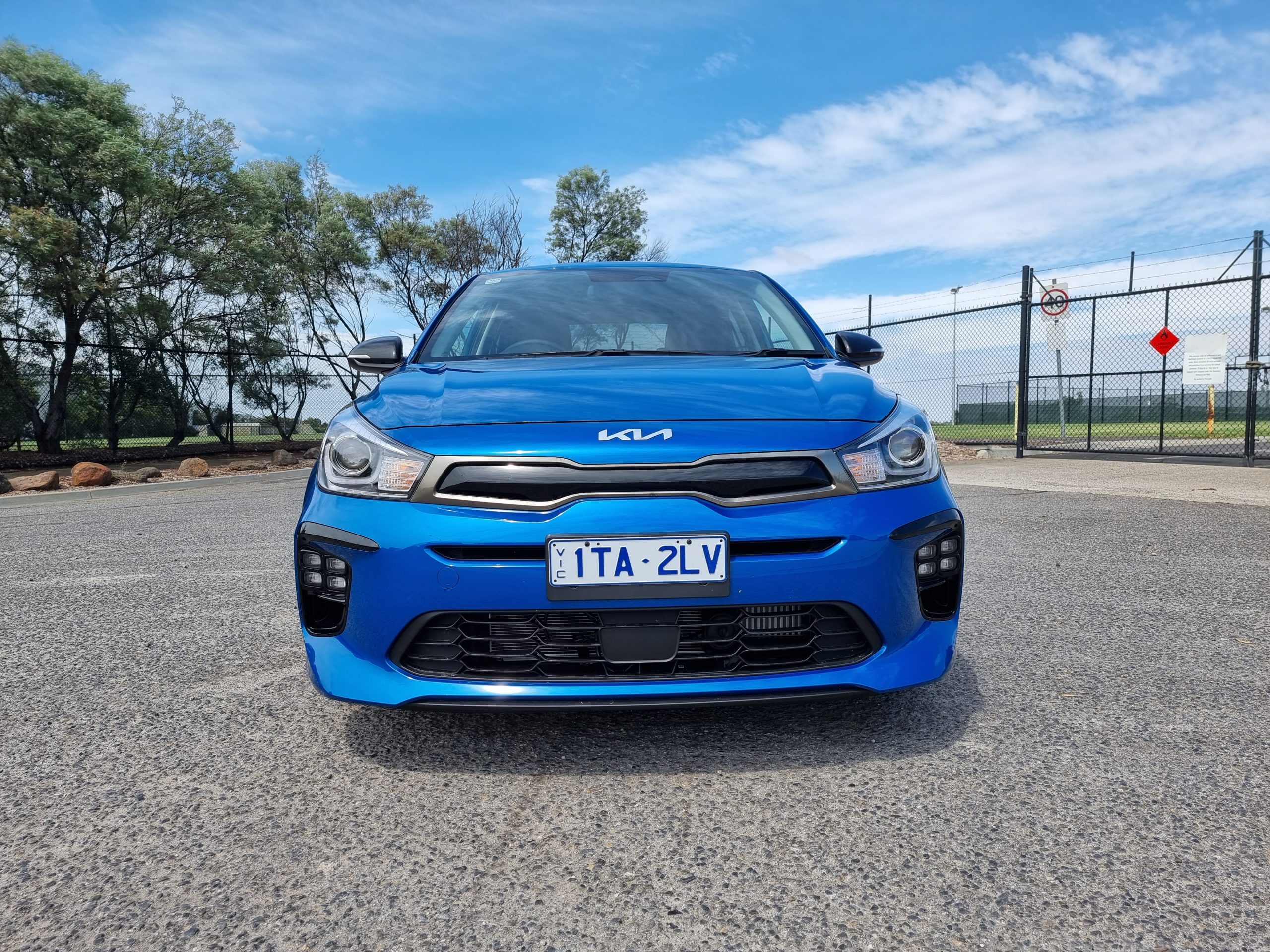
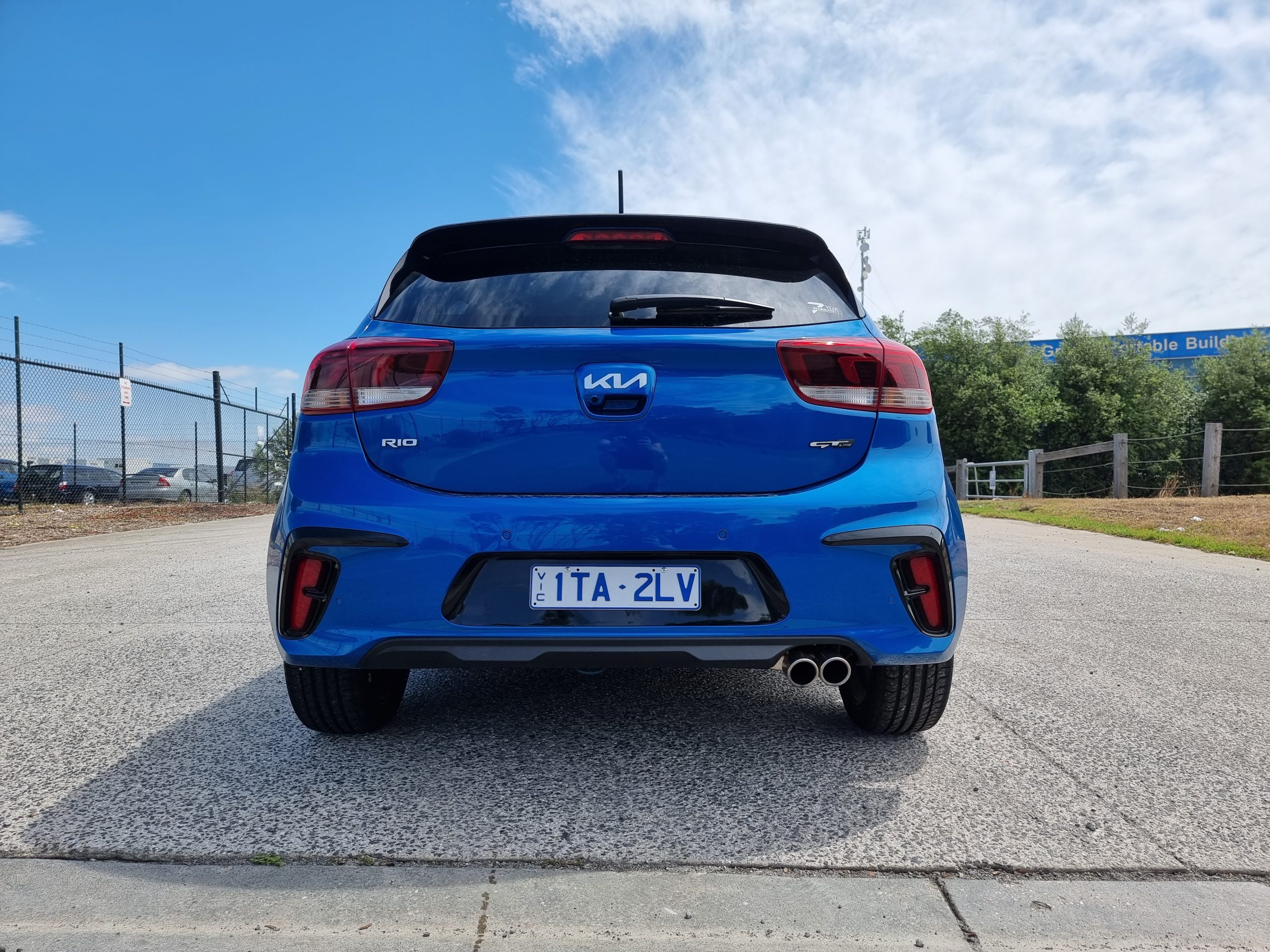
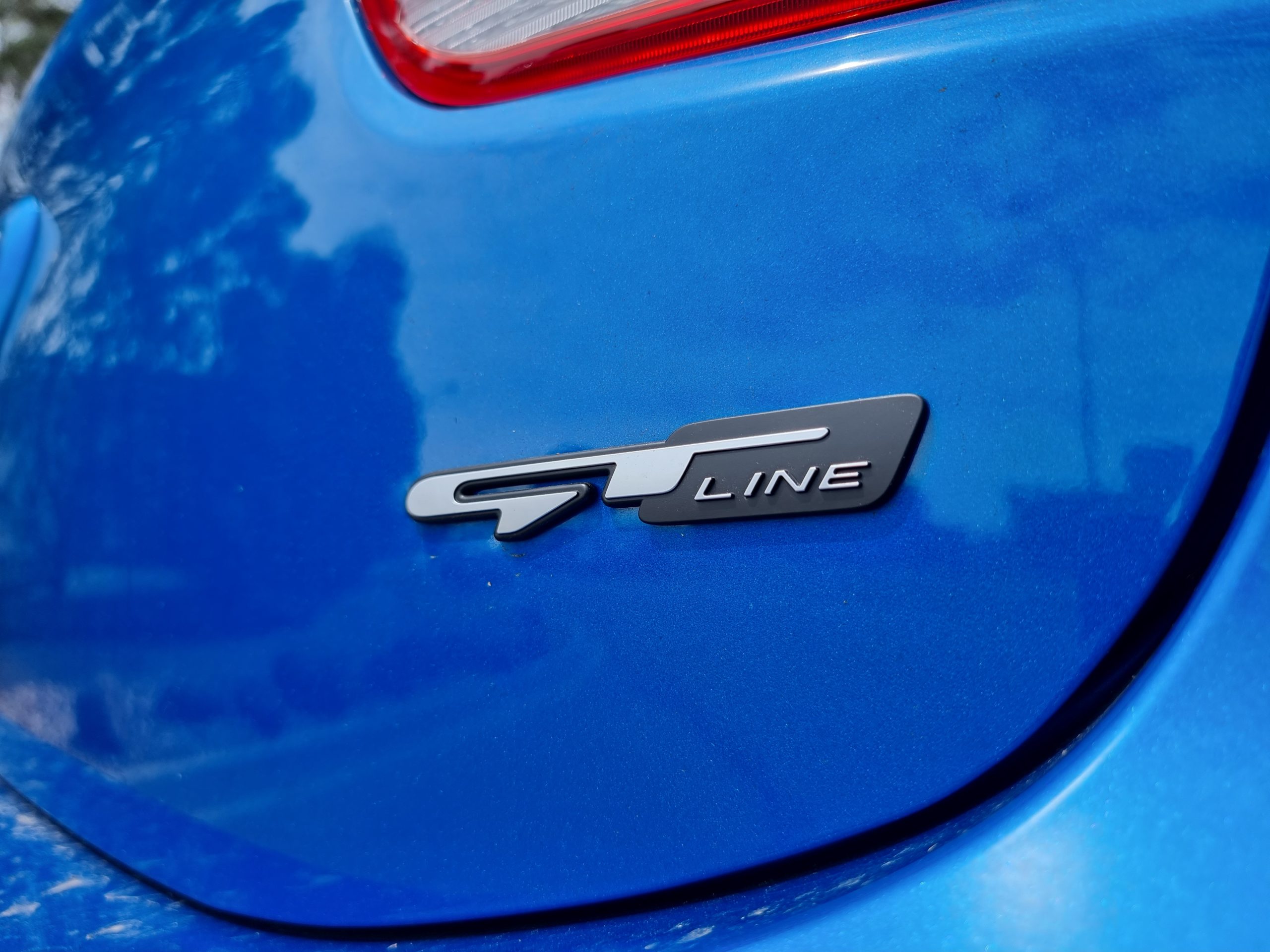
This fourth-generation Rio debuted back in 2016 and once again proved that Kia is capable of making desirable, value-packed cars. Here we tested the most expensive Rio on sale locally: the flagship dual clutch auto-only GT-Line ($27,990 drive away). Normally, small cars are best sampled in their base model form, but this Rio is the only one in the seven models in the Rio range to have a modern turbo petrol engine. So is this Rio, full of bells and whistles worth its price tag with its turbocharged power, and the most generous amount of kit Kia could throw at it? Let’s find out.
Price & Equipment: 6/10
Base model small hatches coming in at under $20,000 drive away are far and few between these days, with buyers flocking to more expensive cars with more kit. Cars such as the recently updated Volkswagen Polo kick off from over $30,000 once on-road costs are included in the price.
Our top of the range Rio GT-Line costs $24,990 plus on-road costs ($27,990 drive away nationwide) topping out the Rio range that enters at $19,090 list for base S. A dual-clutch automatic transmission is standard and there’s no option of a manual. One of five optional colours, such as our test car’s ‘Sporty Blue’, will set you back an additional $520.
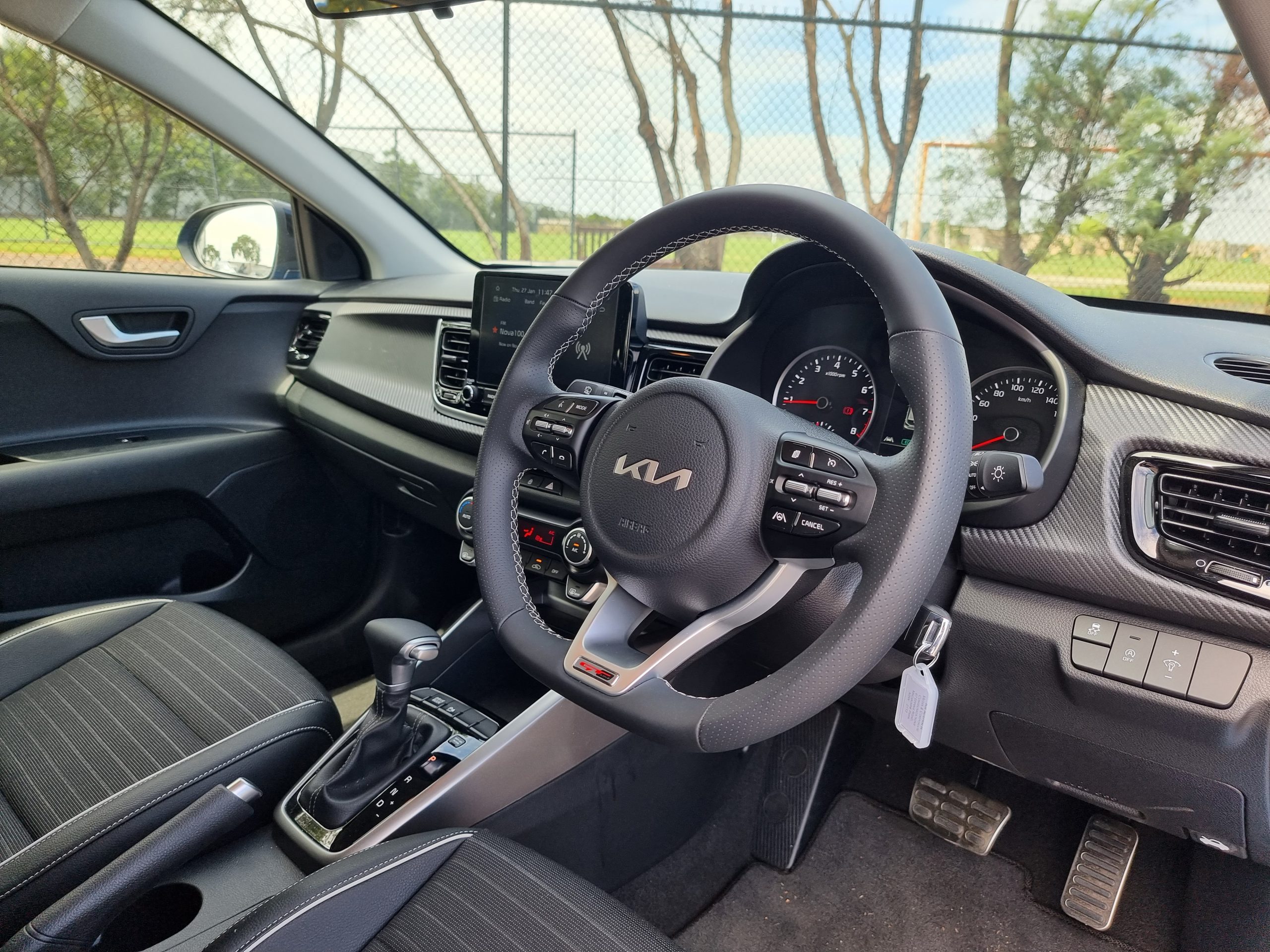
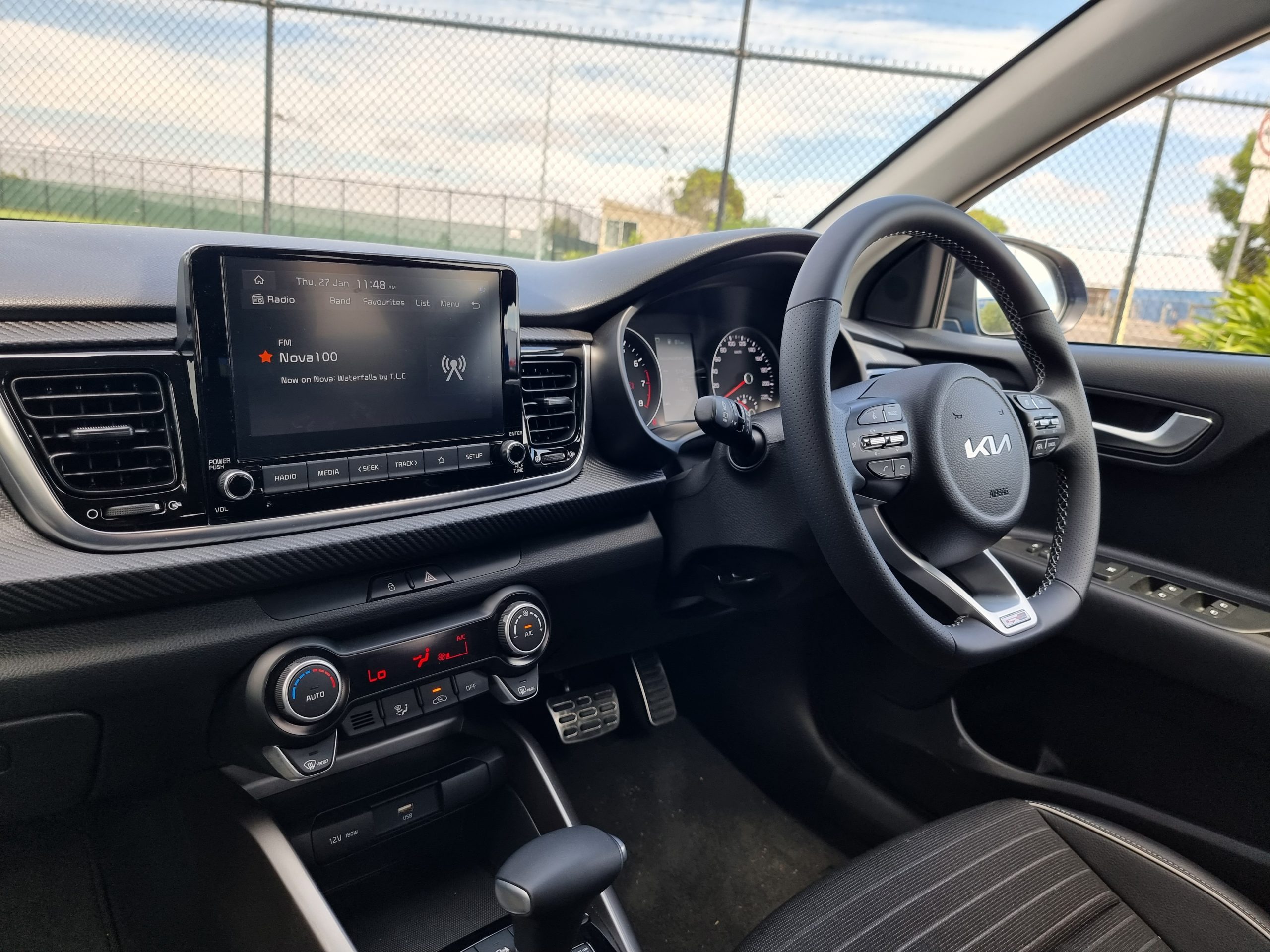
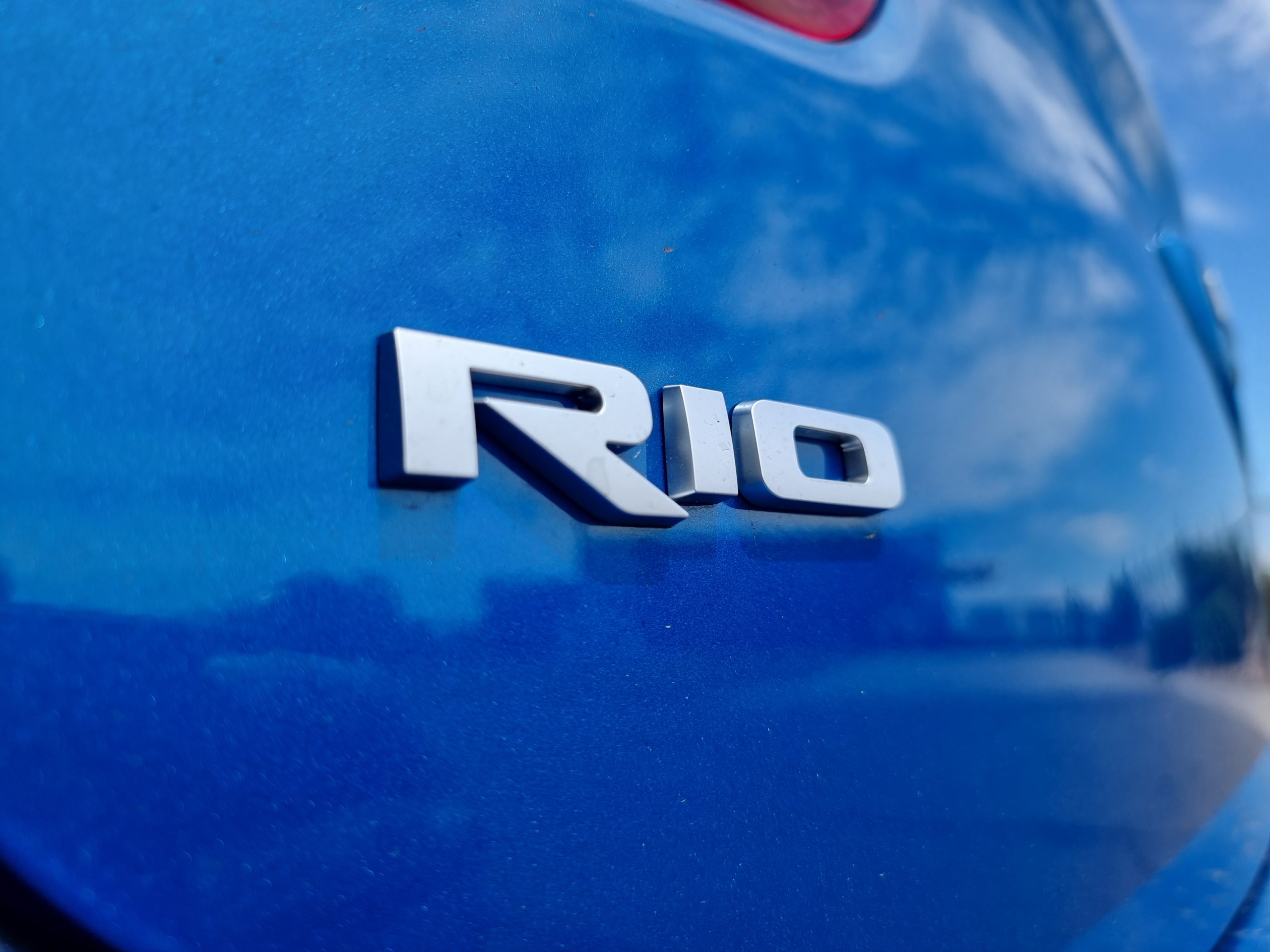
Standard equipment includes a relatively large 8.0-inch multimedia touchscreen with wireless Apple CarPlay and Android Auto, single-zone climate control air conditioning, sports seats with a leatherette and fabric trim, a GT-Line specific faux leather steering wheel, cruise control, alloy pedals, carbon-look trim inserts, a single 12-volt and dual USB-A outlets in front of the centre console.
Outside, the GT-Line comes with sporty accents such as 17-inch alloy wheels, a GT-Line body kit and bespoke grille garnish, rear privacy glass, along with automatic halogen headlights with LED daytime running lights and LED ‘ice cube’ front fog lights, heated and electric-folding mirrors, keyless entry and start and automatic wipers.
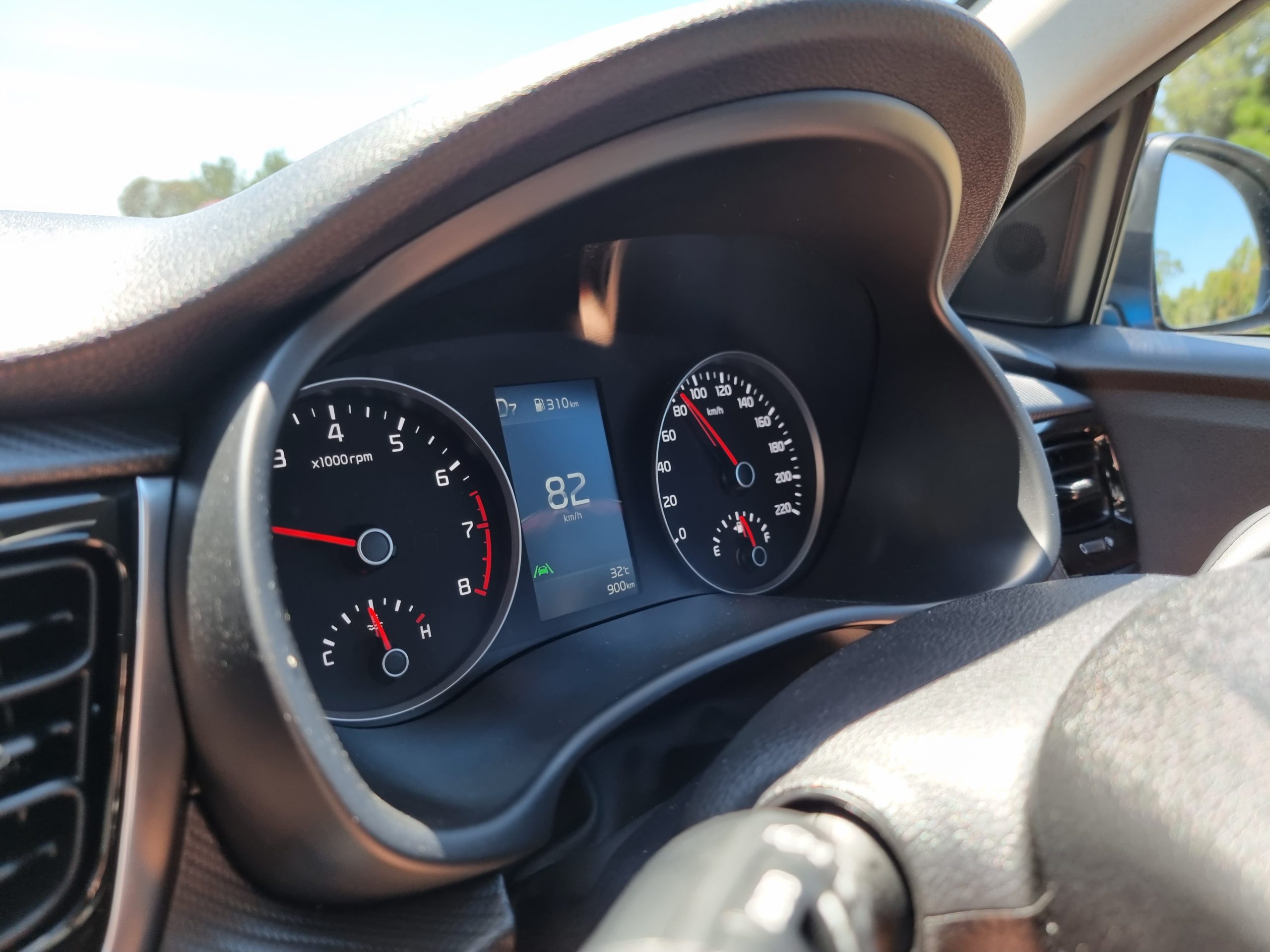
Safety kit includes six airbags, auto emergency braking (AEB) with pedestrian and cyclist detection, lane keep assist, driver attention alert with leading vehicle departure alert, a reversing camera and rear parking sensors.
Sadly, even this top of the range Rio doesn’t come with the things we’d expect from a fully-loaded small hatch, including inbuilt satellite navigation, adaptive cruise control, LED headlights, heated front seats, a heated steering wheel, blind-spot monitoring with rear cross-traffic alert (both with braking) and lane follow assist. All of these features are available on overseas Rio models, but not here.
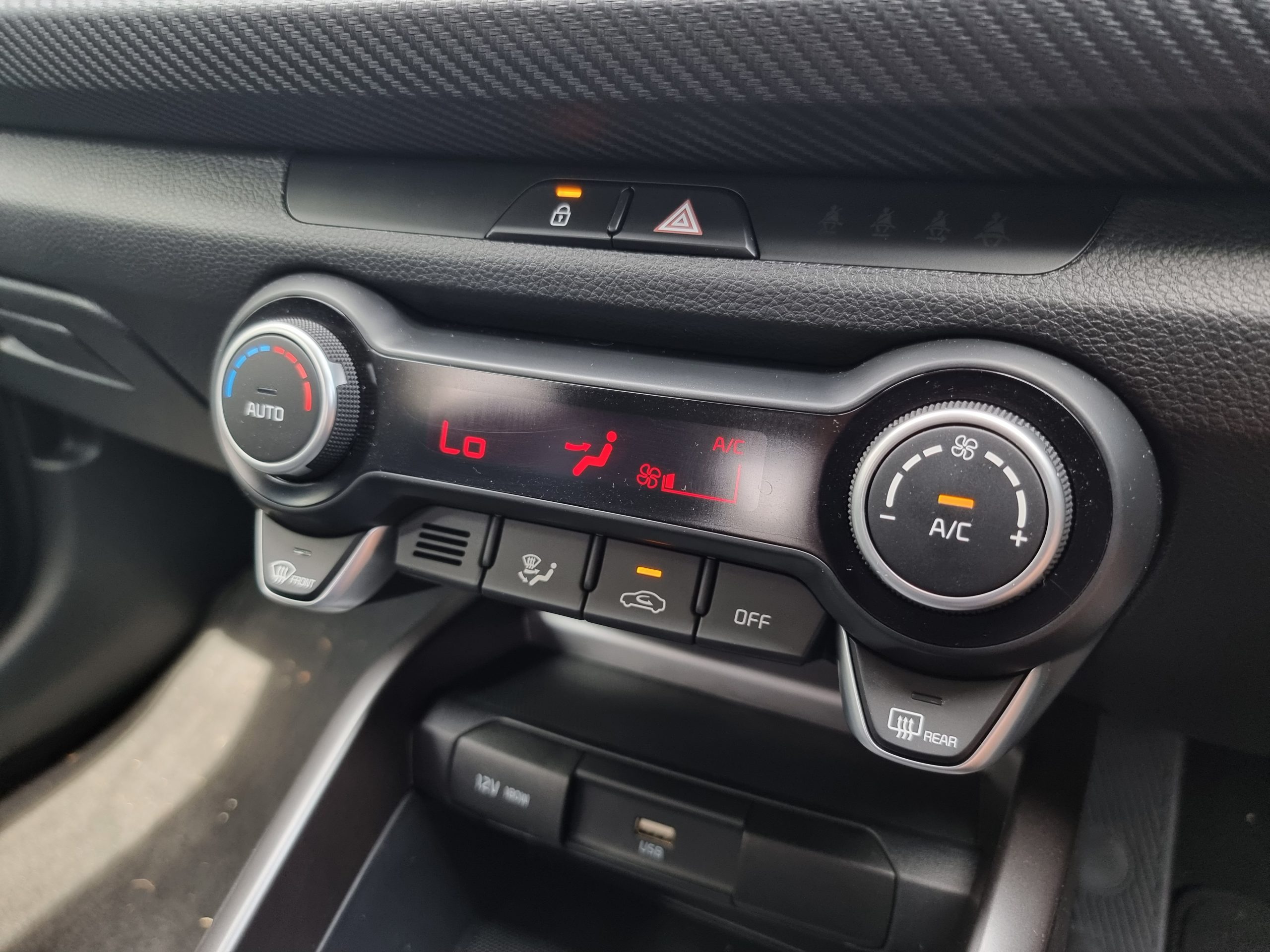
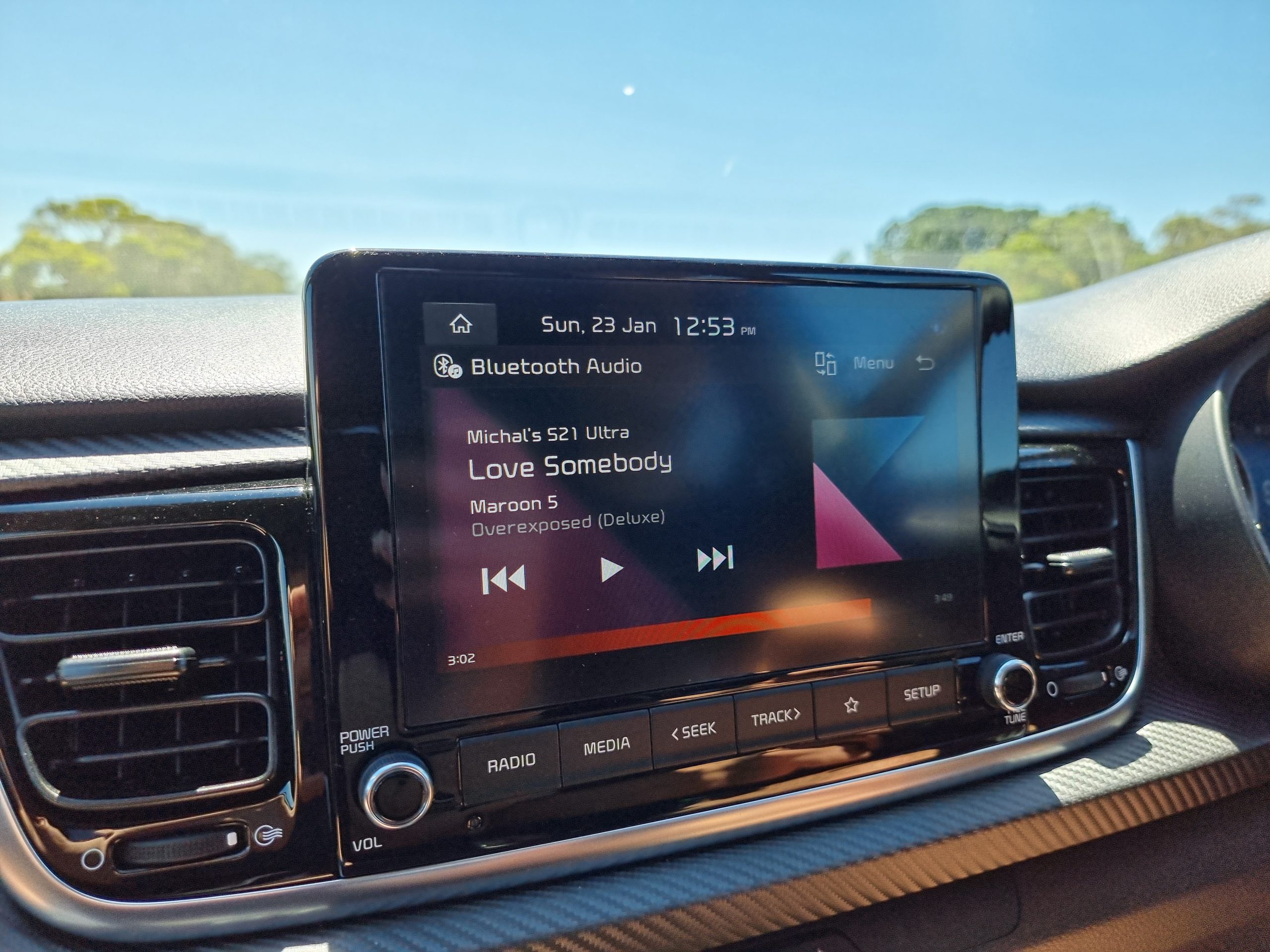
The Rio’s key rivals have also gone up in price with some small hatches such as the Suzuki Swift GLX Turbo at $26,790 plus on-road costs and the Toyota Yaris SX Hybrid $27,020 plus on-road costs, both costing more than the Rio. The Swift GLX beats the Rio GT-Line’s spec with its LED headlights and more comprehensive driving assistance features such as adaptive cruise and auto high beam, along with a peppier drivetrain. The Yaris’ hybrid drivetrain is worth its weight in gold and is super frugal while the Yaris’ advanced safety tech gives it further step up on the Rio. Neither is able to match the Kia’s warranty, however.
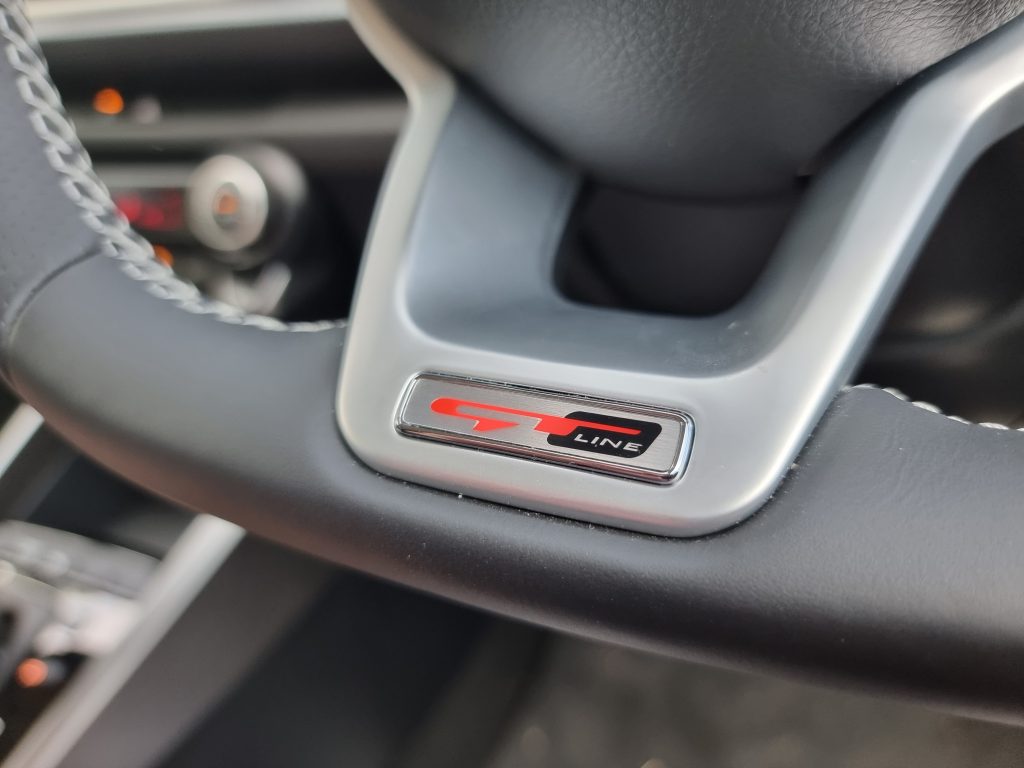
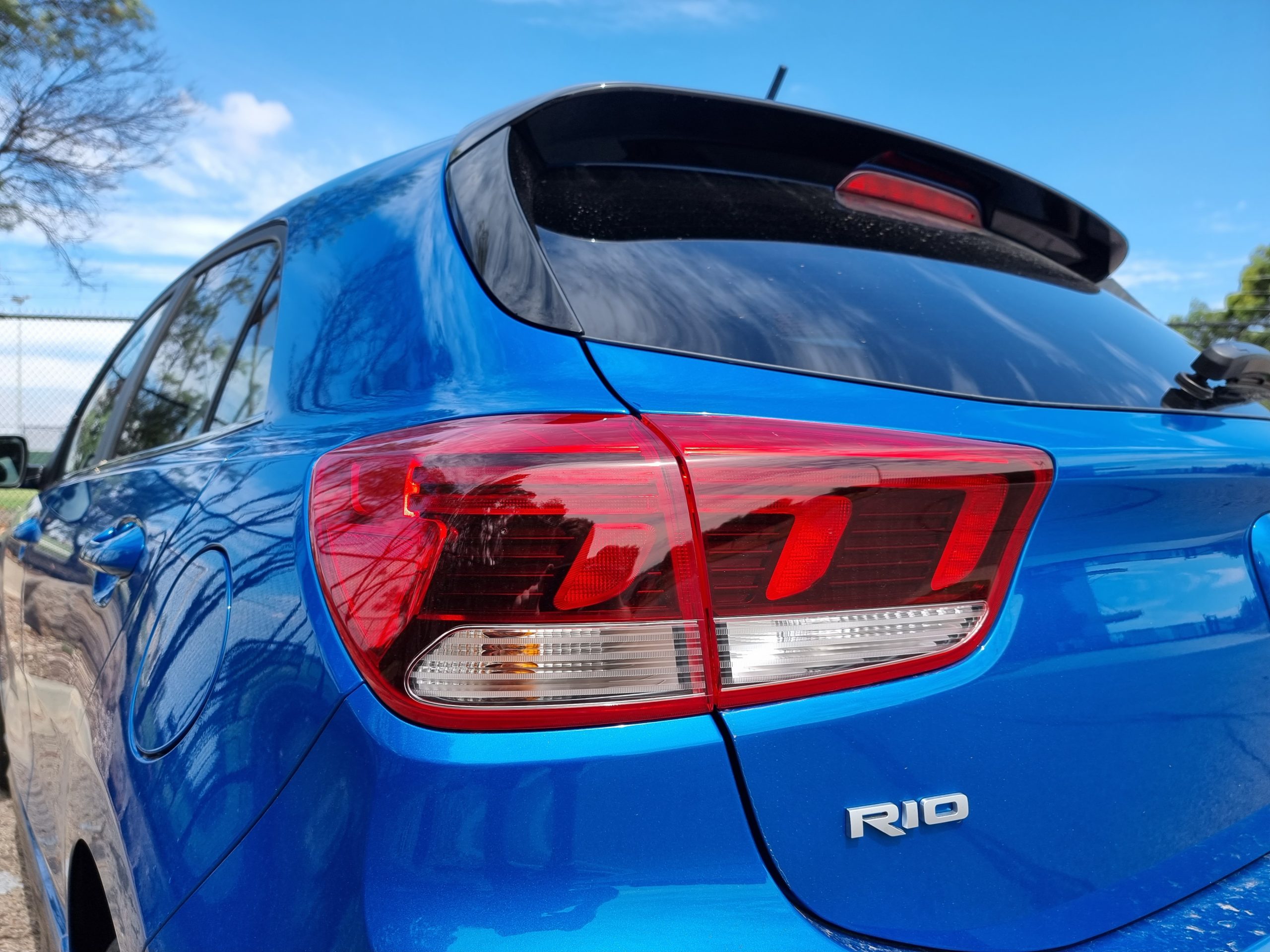
The Rio GT-Line isn’t necessarily bad value, we just think it makes more sense in humbler specs. A base model kia Cerato S with the optional safety pack is a paltry $1,000 more than the Rio GT-Line. The Cerato is a larger car than the Rio, and might miss out on alloys or some of the sporty details the Rio GT-Line comes with, but it’s an altogether more substantial car and worth the extra over the top spec Rio.
Performance & Economy: 7/10
The 2022 Kia Rio GT-Line comes with a dinky 1.0-litre turbocharged three-cylinder engine under its bonnet pumping out 74kW of power and a very respectable 172Nm of torque from just 1,500rpm. With power being sent through Kia’s own seven-speed dual-clutch transmission driving the front wheels, the Rio feels sprightly and decidedly more premium than the lesser models in the Rio range, which come powered by an ancient four-cylinder engine without a turbo. Weighing 1,197kg, the Rio isn’t as light as the lightest cars in its class which further blunts the engine’s otherwise decent outputs.
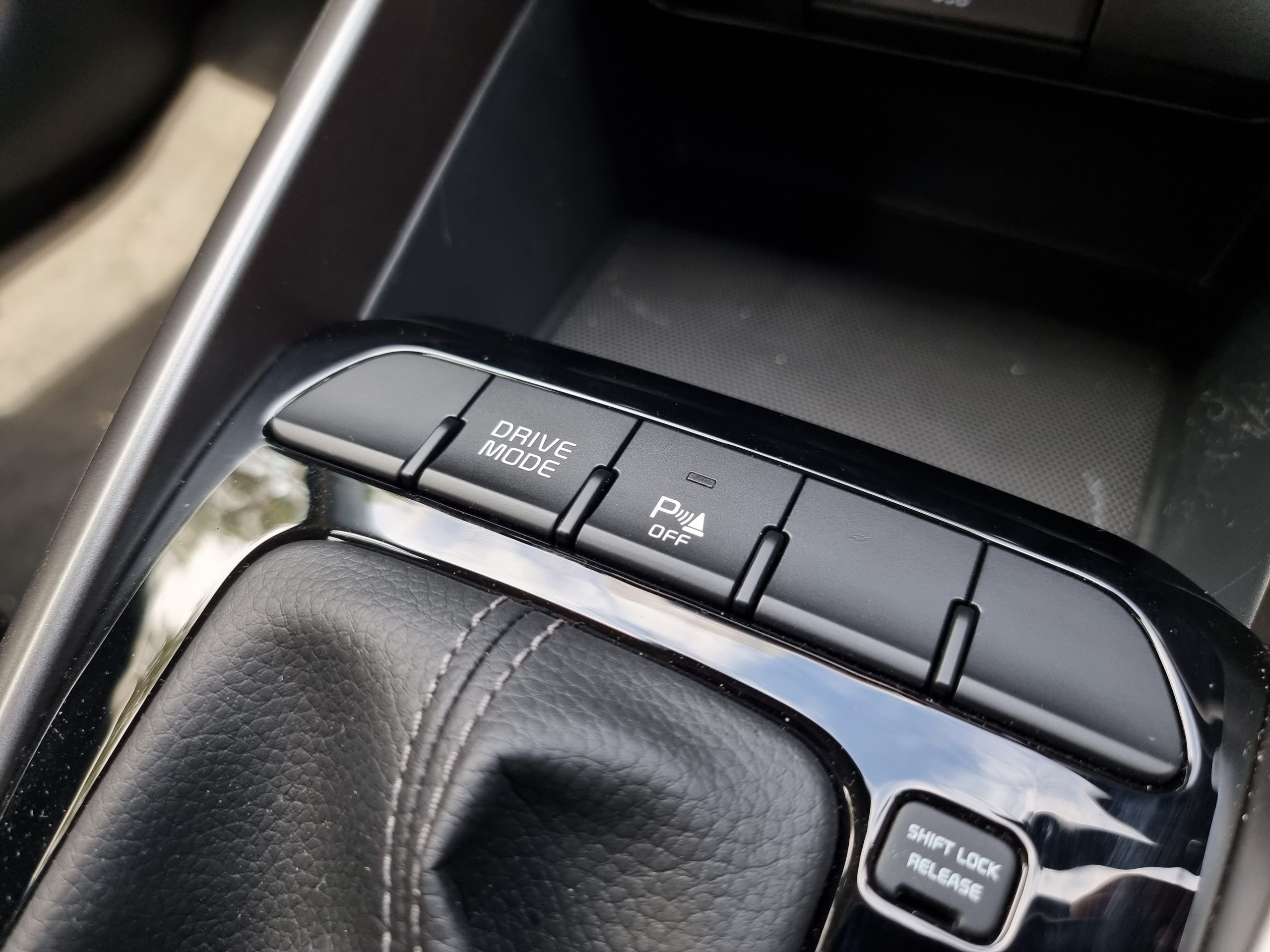
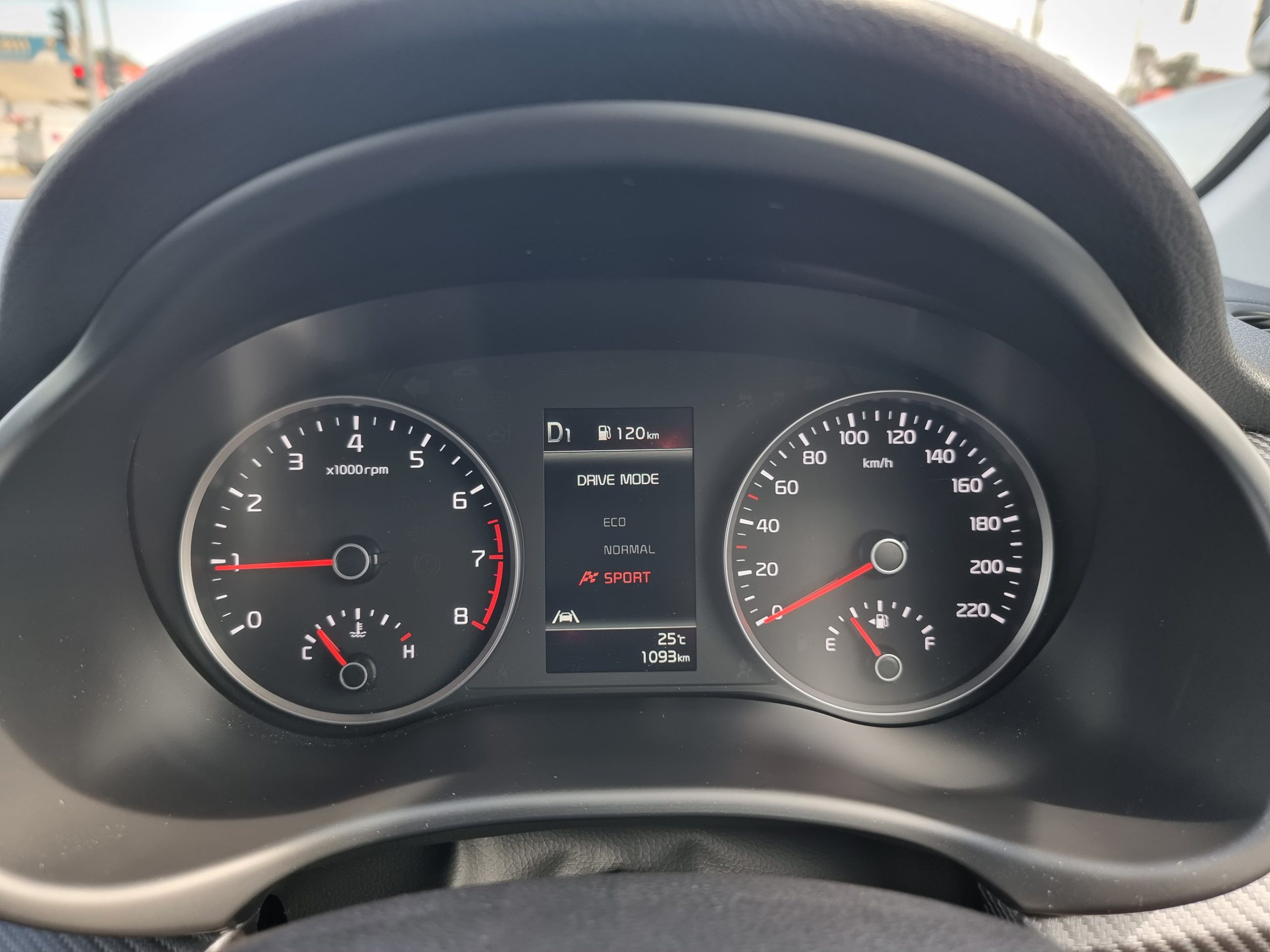
Despite the power cut (88kW down to 74kW) and lacking the mild-hybrid system on offer in Europe, the three-cylinder engine sounds wonderful under acceleration and moves the Rio along with ease. Don’t expect it to have the same gusto out of town as more powerful engines however, as overtaking manoeuvres take planning due to the lack of power on offer.
Oddly, the gearbox reverts to the Eco drive when starting the Rio up. This leads to mushy throttle response and an almost undrivable car around town, with the gearbox always selecting the highest gear possible. In other drive modes, the gearbox works rather well with seamless gearshifts and some of the usual dual-clutch foibles we’ve come to expect at lower speeds. A word of warning with the stop/start system – turn it off as it shakes the car violently when restarting the engine.
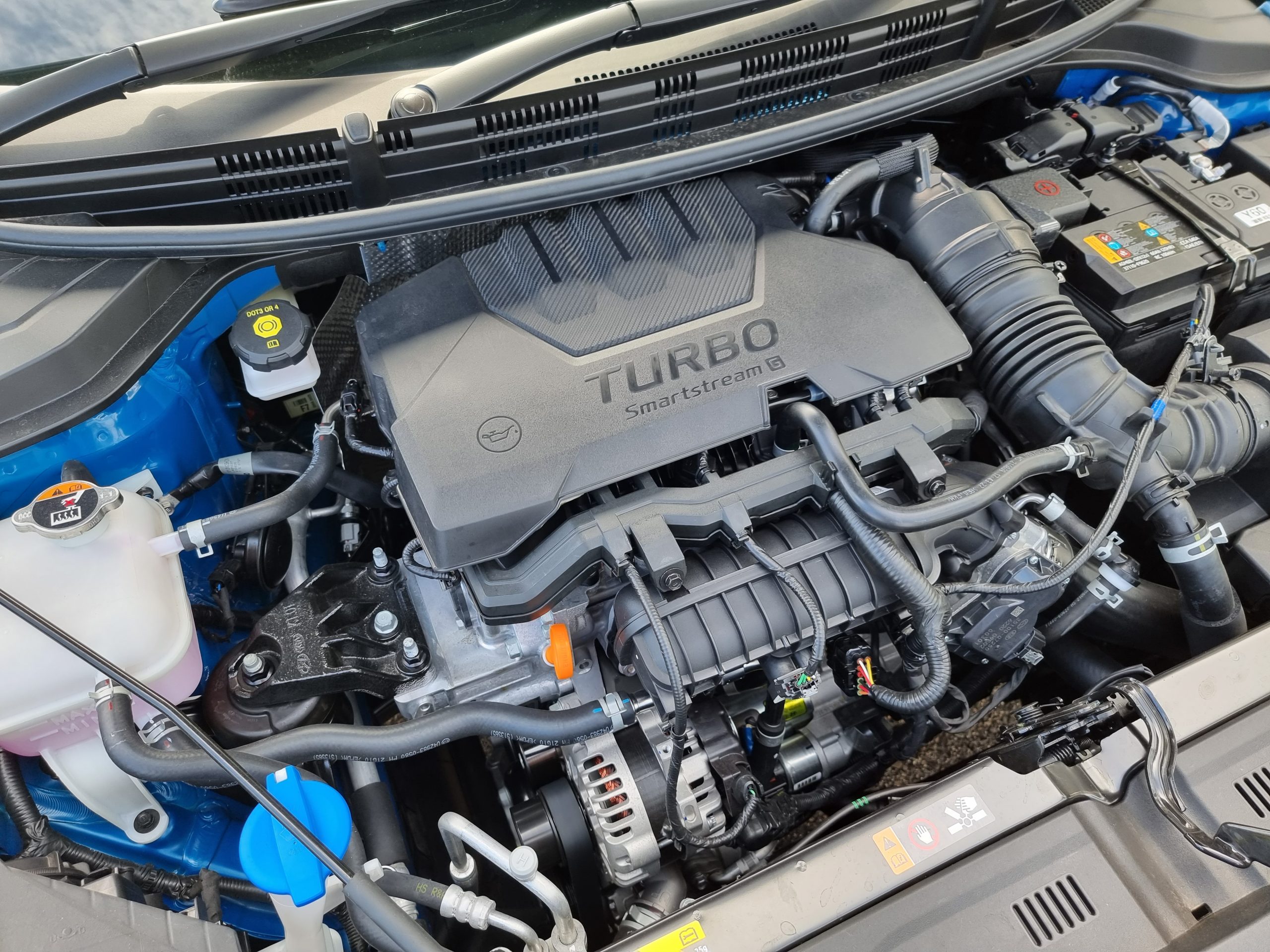
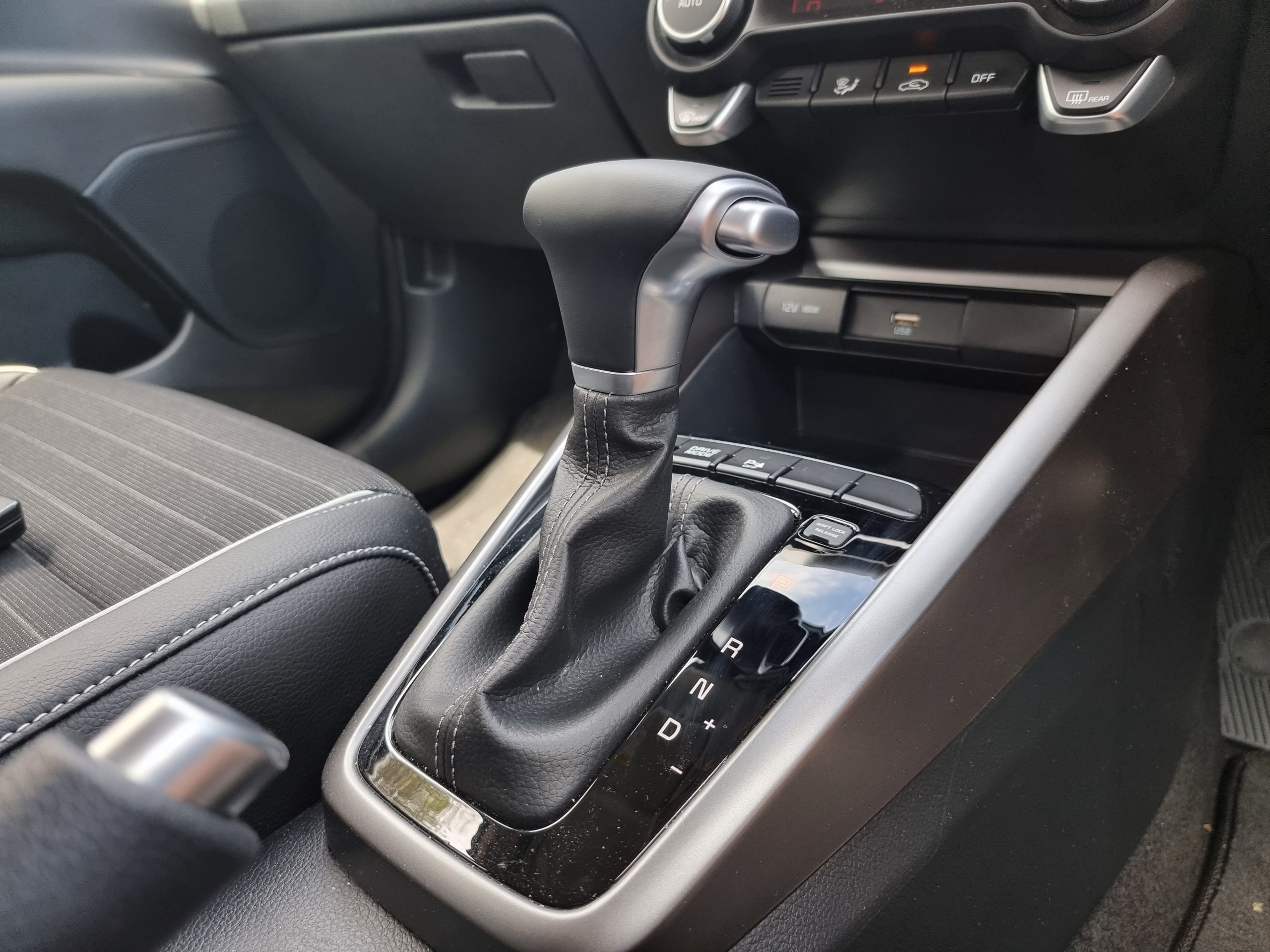
The Kia Rio GT-Line runs happily on regular 91-octane fuel, with Kia claiming it will return a decent 5.3L/100km combined claimed consumption. During our week, coving a mixture of urban and freeway driving, our Rio returned 7L/100km and a freeway trip down the Mornington Peninsula saw that consumption figure drop to 5L/100km.
We’d still prefer Toyota’s wonderful three cylinder hybrid drivetrain used in the Yaris. The Yaris’ real world fuel economy is astounding, and the engine and electric motor work well together to make the Yaris feel sprightly, without any of the dual-clutch transmission foibles the Rio displays.
Ride & Handling: 7.5/10
Like most Australian Kias, the Rio drives well and impresses with some talent to surprise and delight keener drivers. The steering is crisp and the chassis responds well to corners. The quality Continental SportContact 5 rubber helps with offering bags of grip even in the wet and overall the Rio feels like a sporty little car to punt along. You certainly wouldn’t get this level of driving nejoyment from small-SUVs, even from its bigger brother the Stonic.
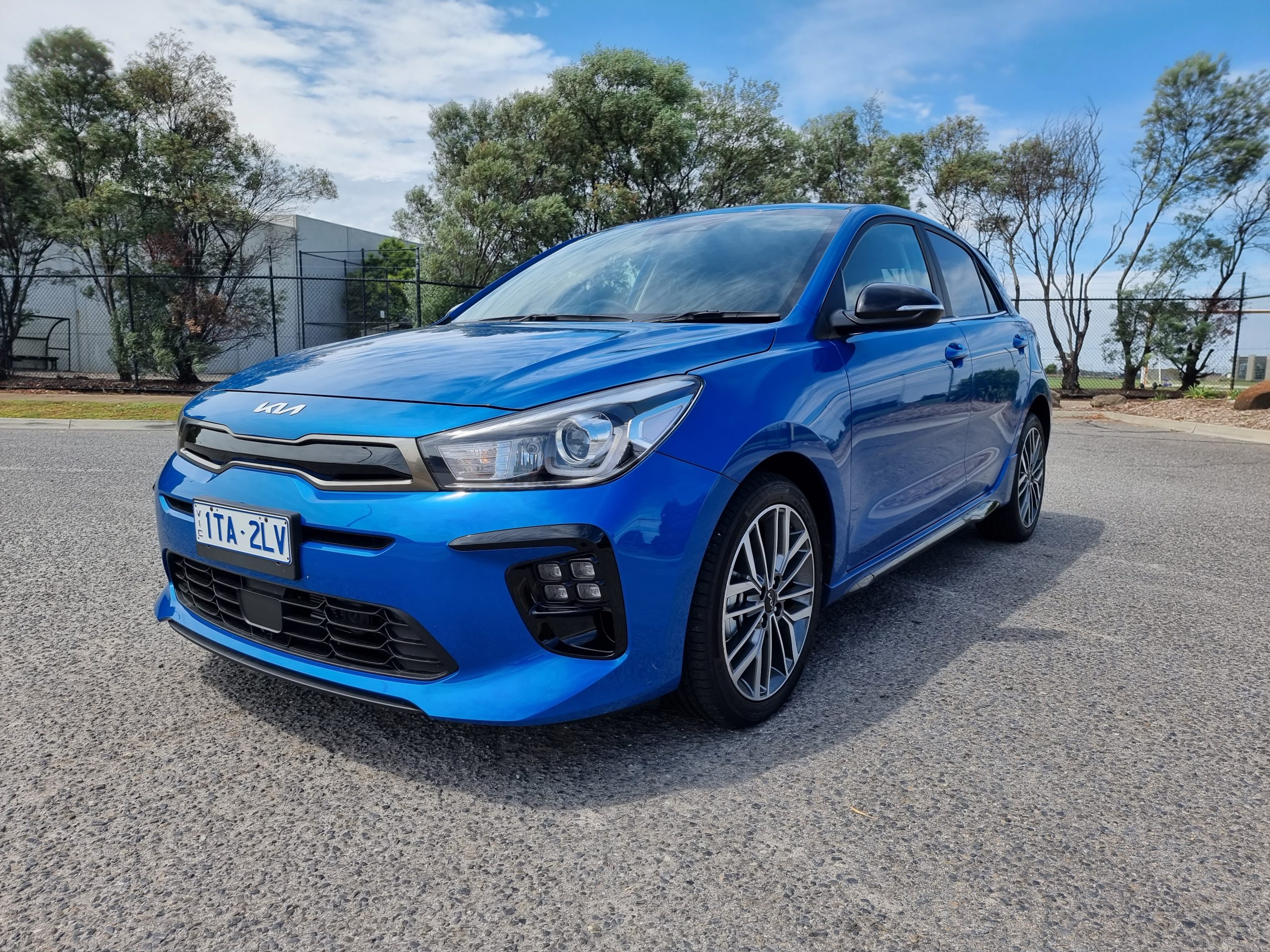
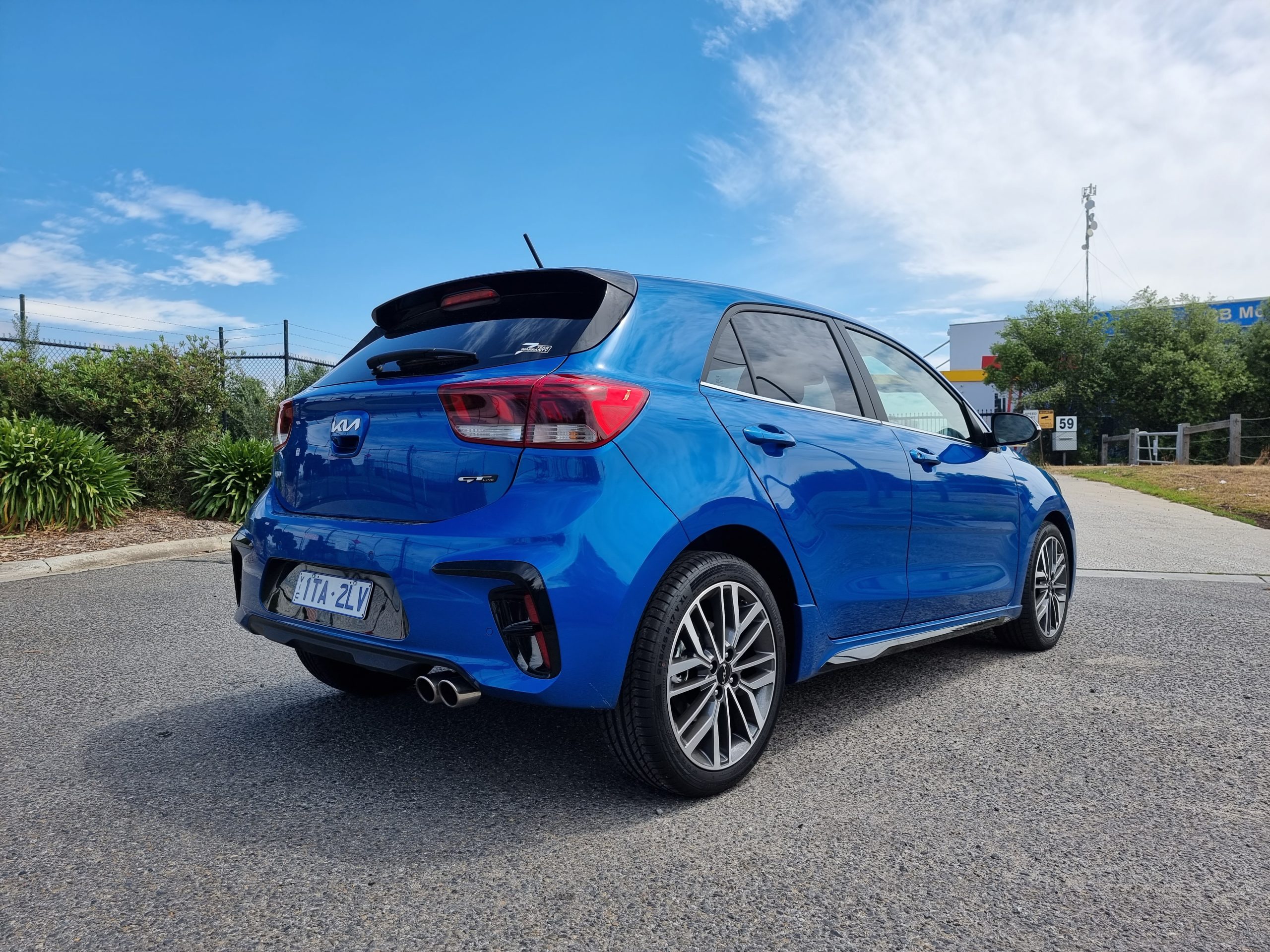
Sadly, the trade-off a bit to that talent in the corners is that ride comfort suffers thanks to the firm damper set-up, which feels stiff around town and can be jarring at higher speeds. from its tautly-damped strut and torsion beam suspension. Road and wind noise are not the best either, with freeway trips accompanied by tonnes of tyre roar at higher speeds.
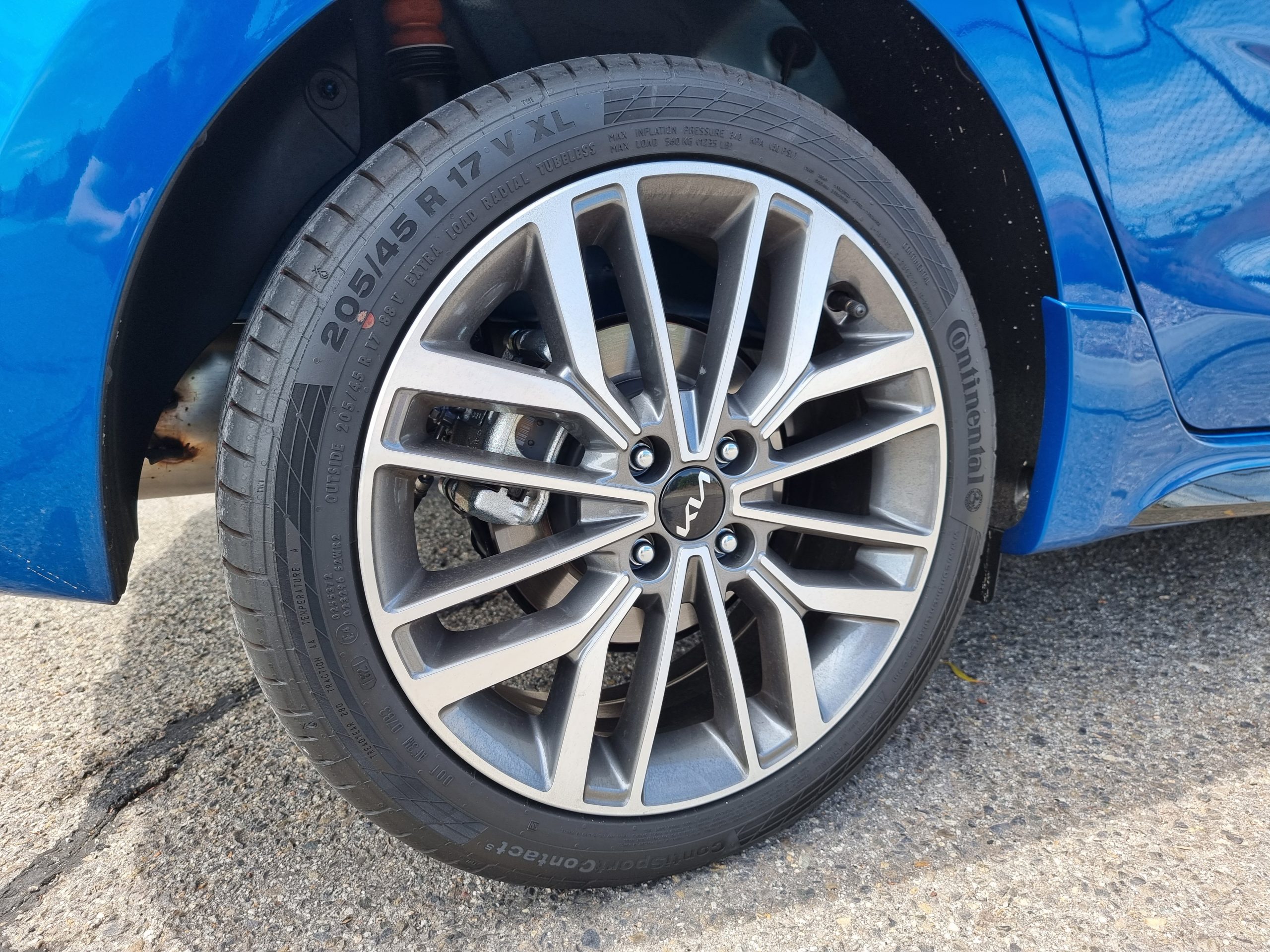
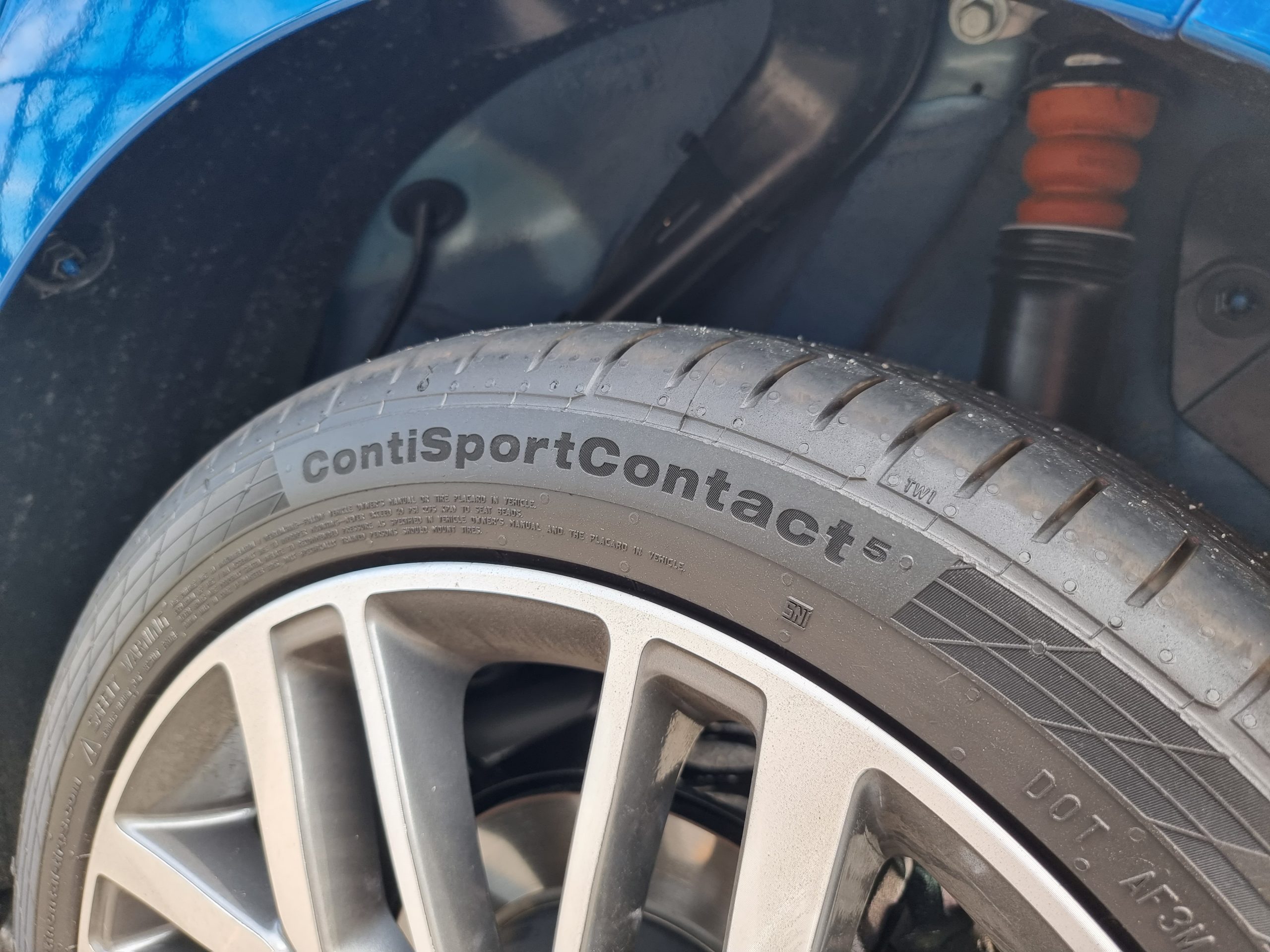
The Yaris is a little more refined in comparison to the top spec Rio, riding a touch smoother over rough roads. The Yaris does however lack the grip and poise of the Rio, meaning it isn’t as much of a joy to punt through corners at speed.
Interior & Practicality: 7/10
The Rio’s interior design feels fresh and contemporary with its large screen, uncluttered feel and sporty seats. The GT-Line’s sporty trim pieces do look good, with tactile satin finishes to the carbon-fibre inlays on the dashboard. Quality is generally good to but there is no escaping the extensive use of hard and shiny plastics used throughout the cabin.
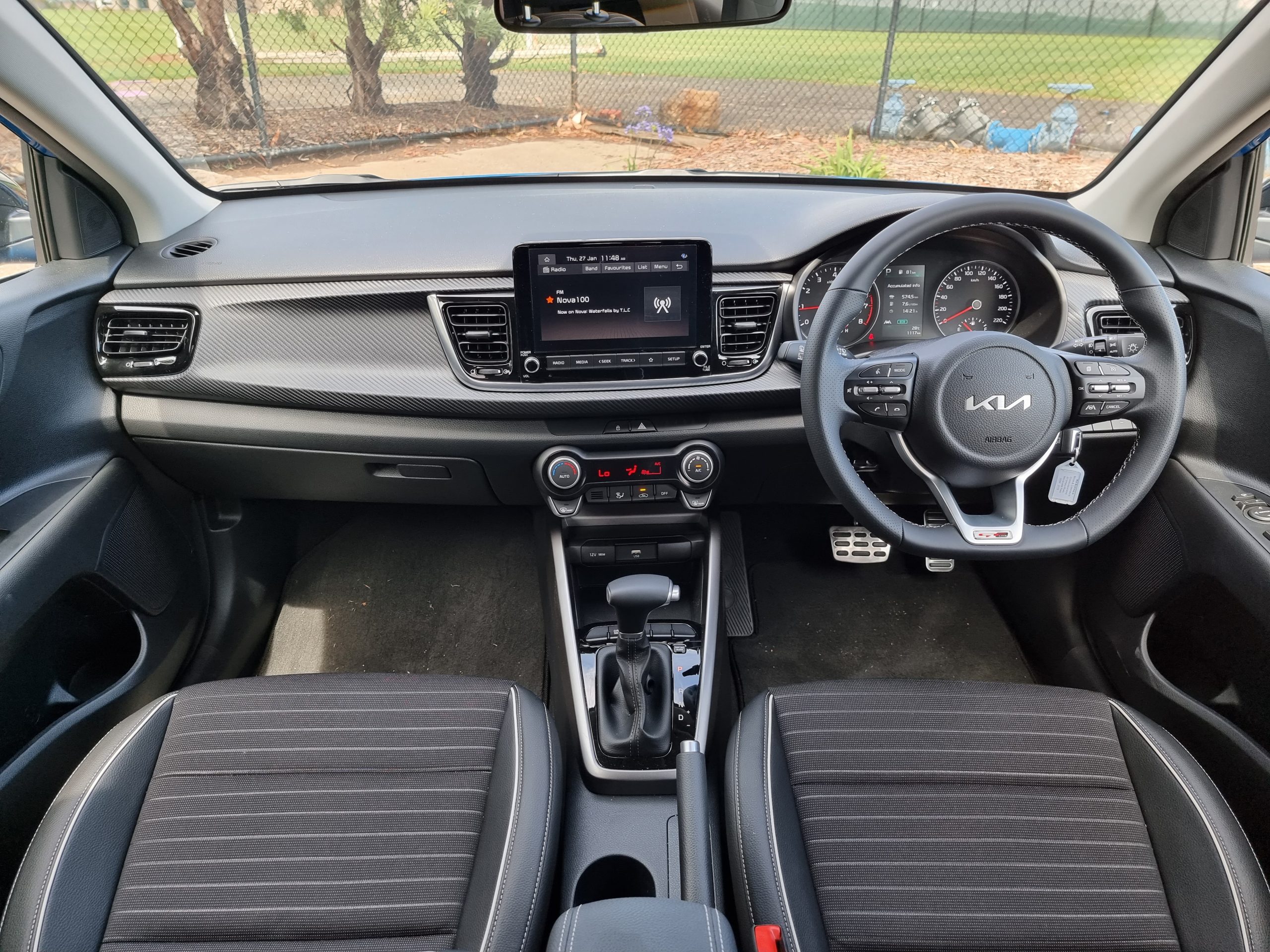
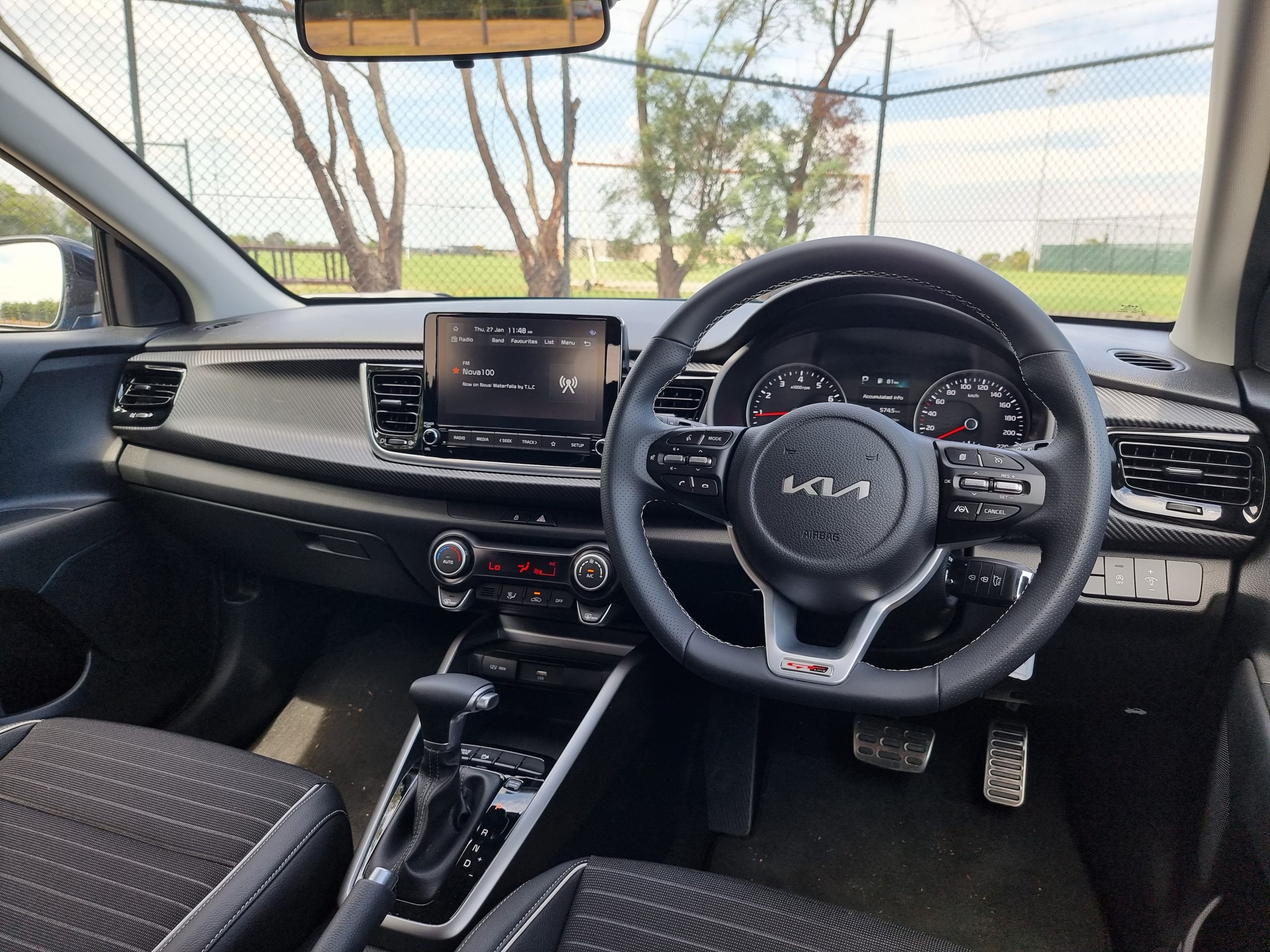
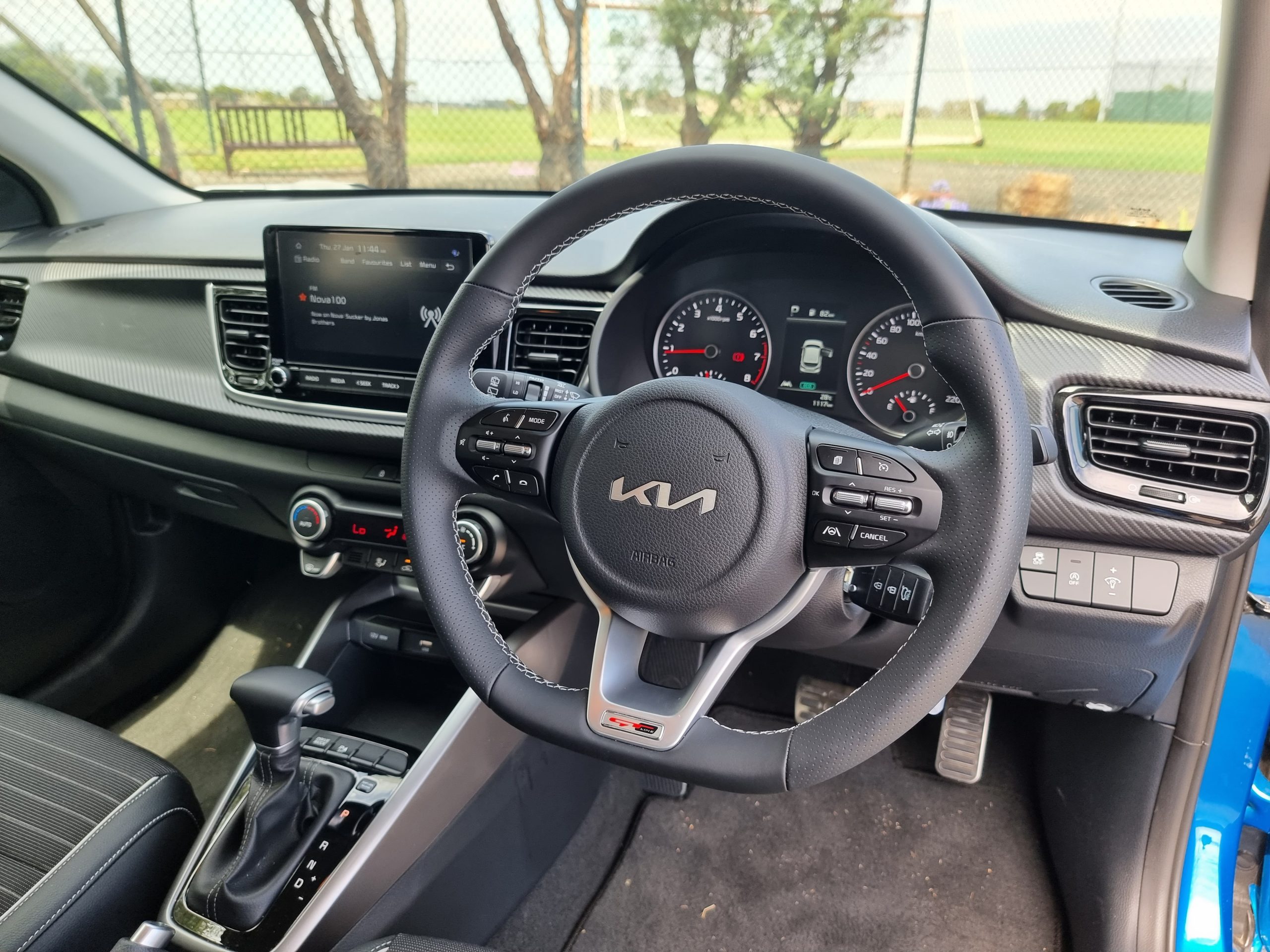
For drivers, the flat-bottomed steering wheel is a delight to hold, even if the massive airbag cover is jarring to look at. The driving position is spot on and will apeal to anyone not after the lofty seating position smaller SUVs offer.
The 8-inch screen is super easy to use, bright enough and looks the business. It feels much more up to date than the dated system in the Yaris and makes the Rio feel high tech, civilised and modern. The Rio’s interior quality isn’t as good as the Yaris’ which features a soft touch dash and more softer materials throughout the cabin.
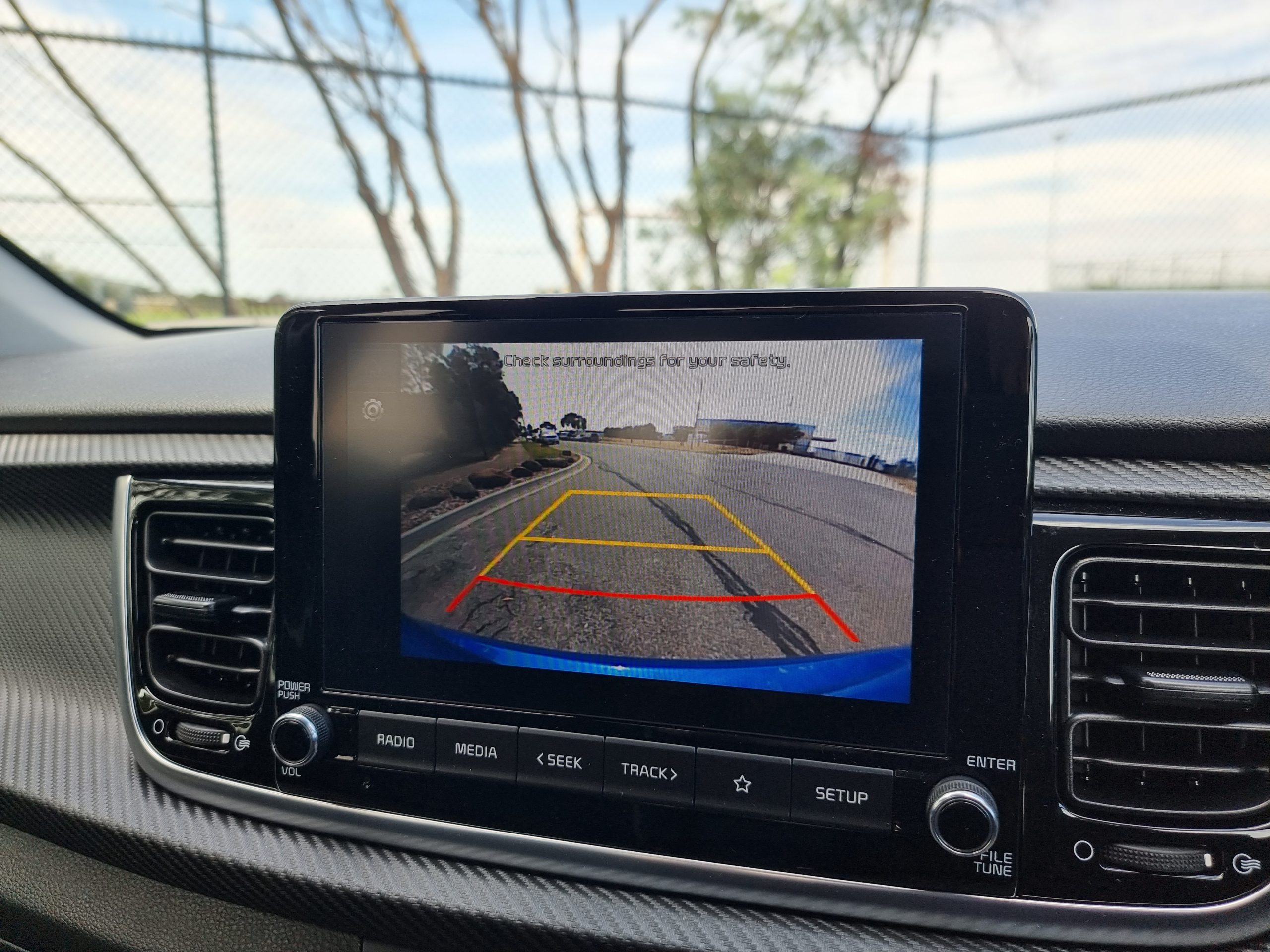
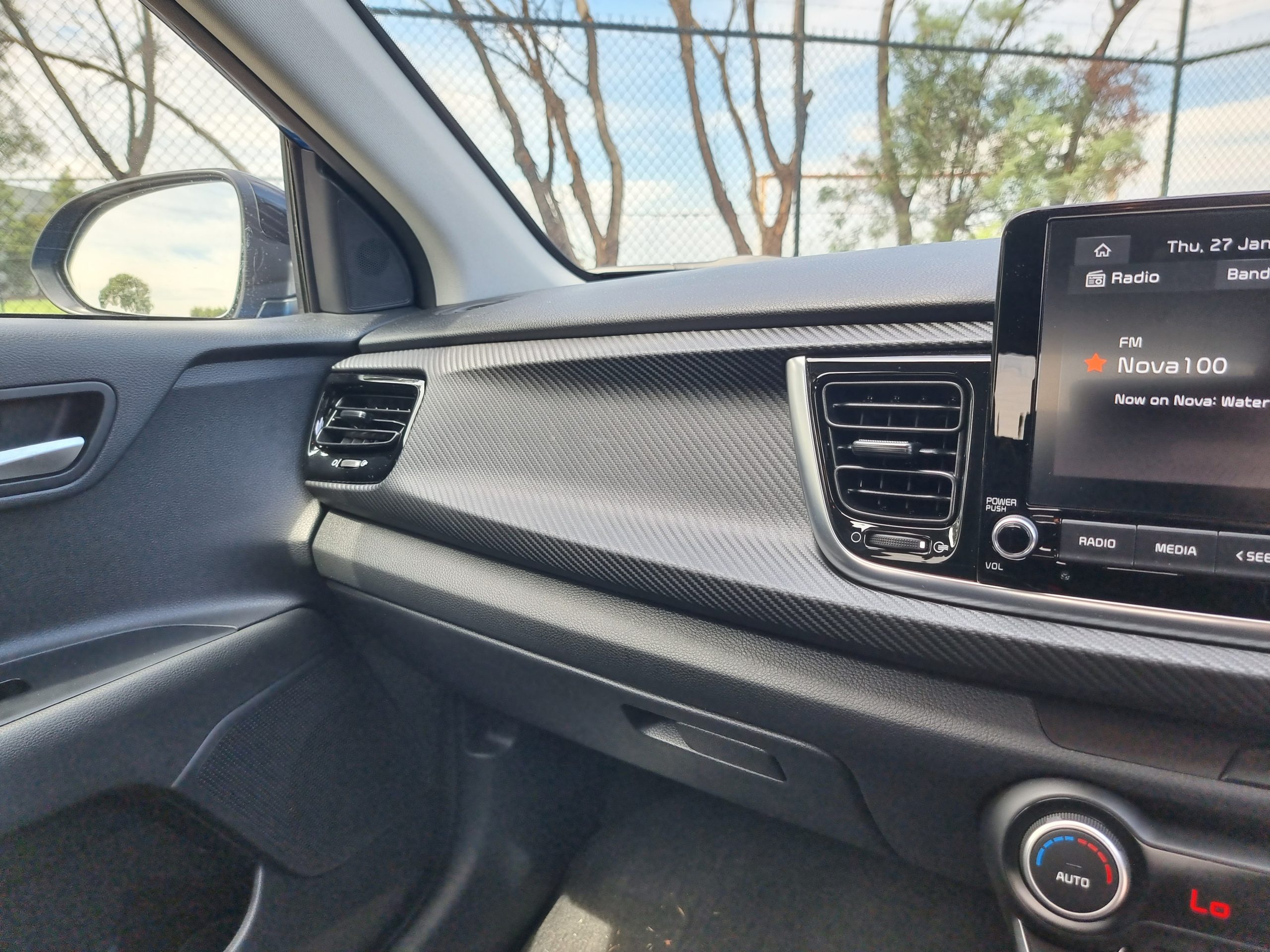
Where the Rio shines is in the amount of interior space on offer. Four adults fit easily into the Rio, with an abundance of head and leg-room for what is a light hatch and one of the smaller cars on sale today. Even rear-seat passengers are well looked after.
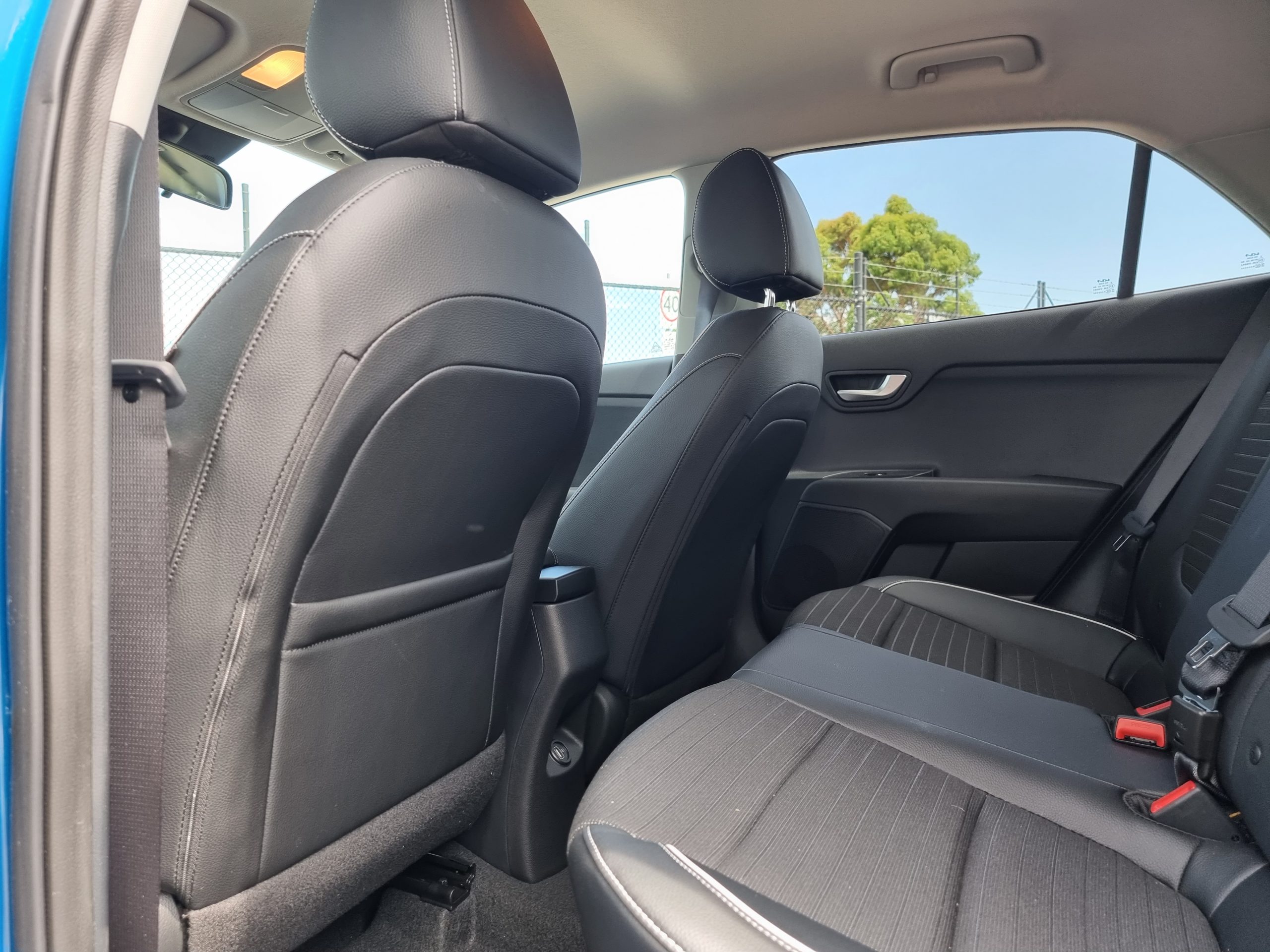
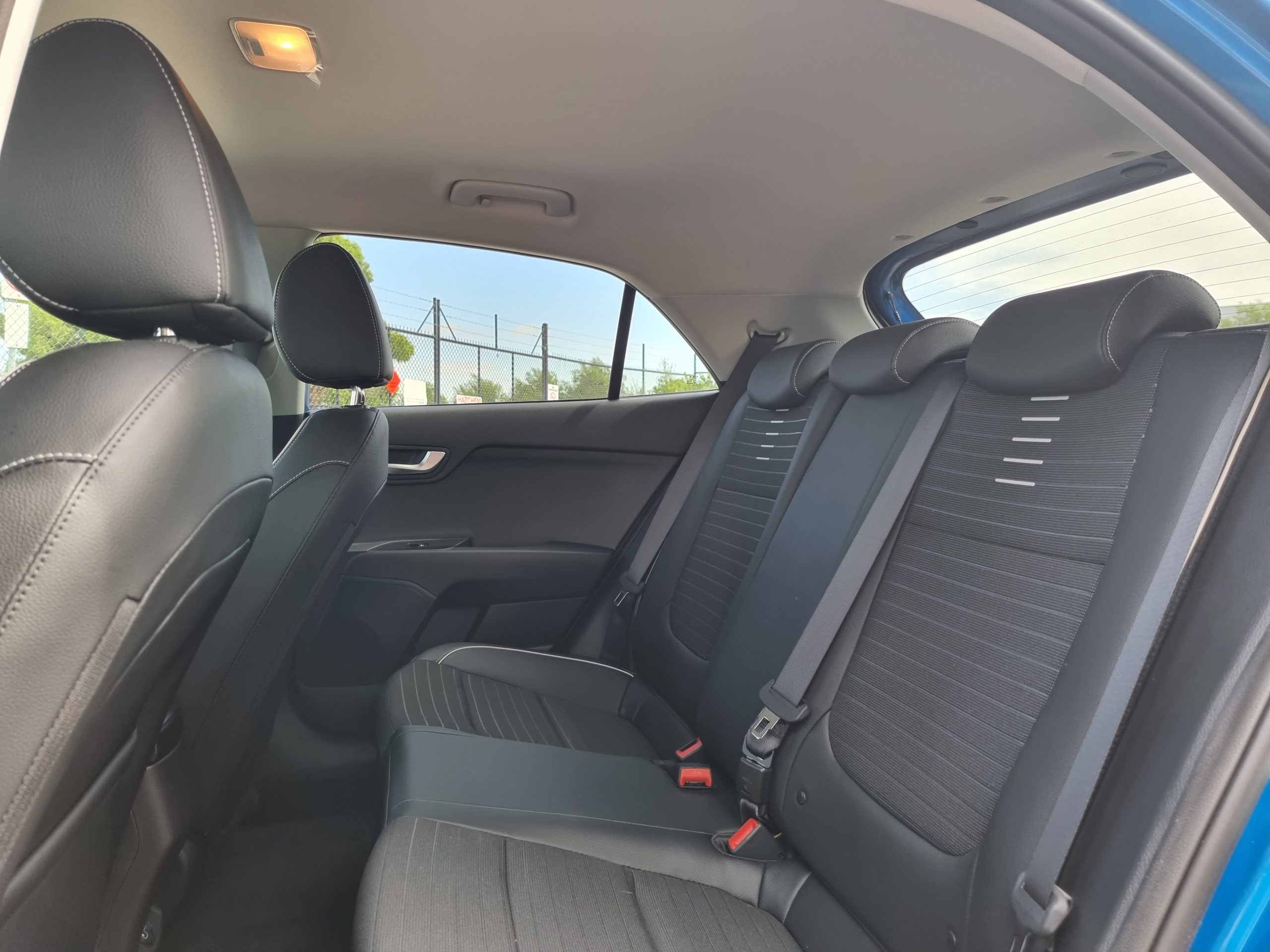
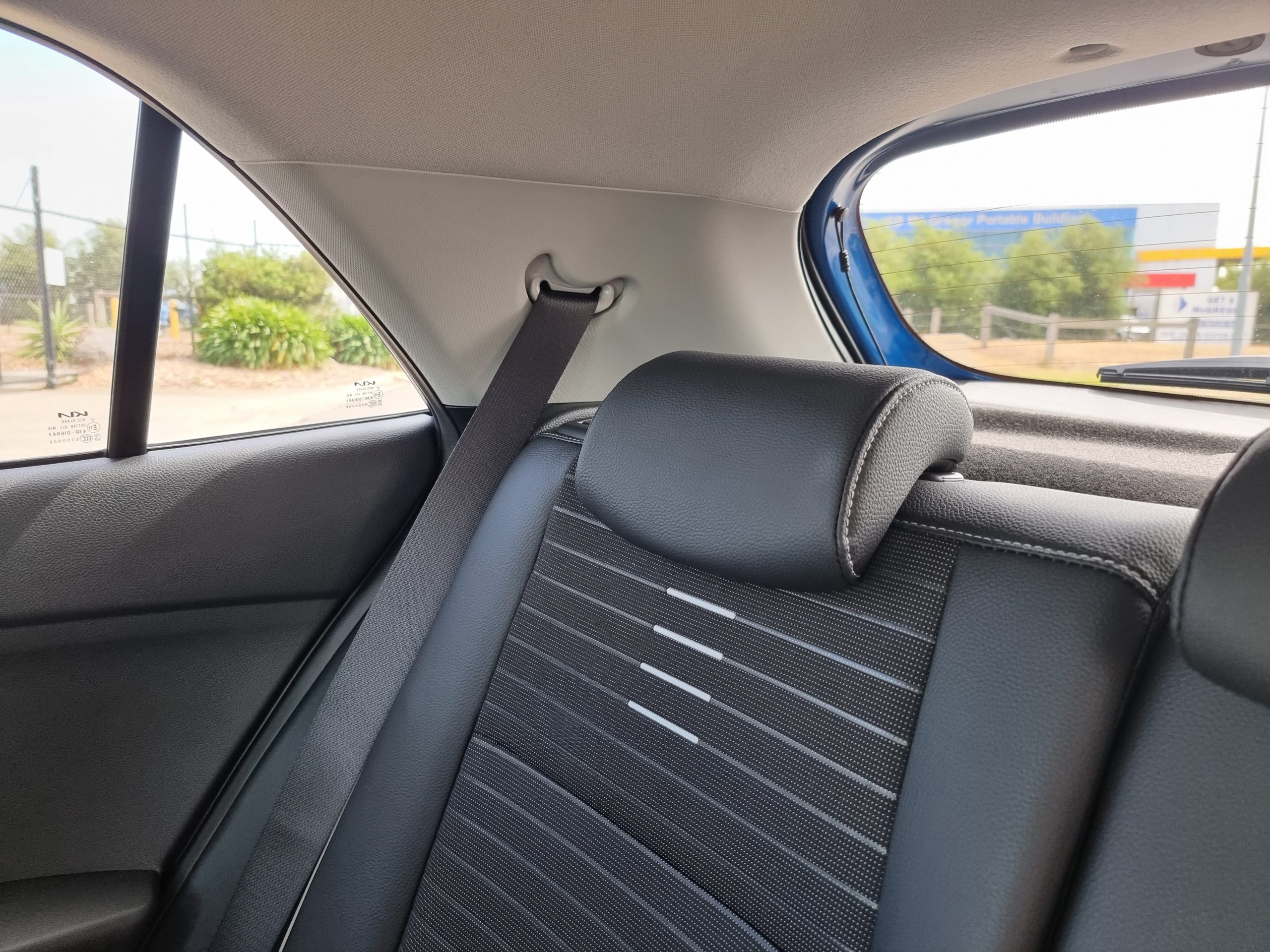
Practicality is well taken care of too, with Kia fitting the the cabin with bottle holders in each of the doors and a solid centre console which also features an armrest, unlike the Yaris.
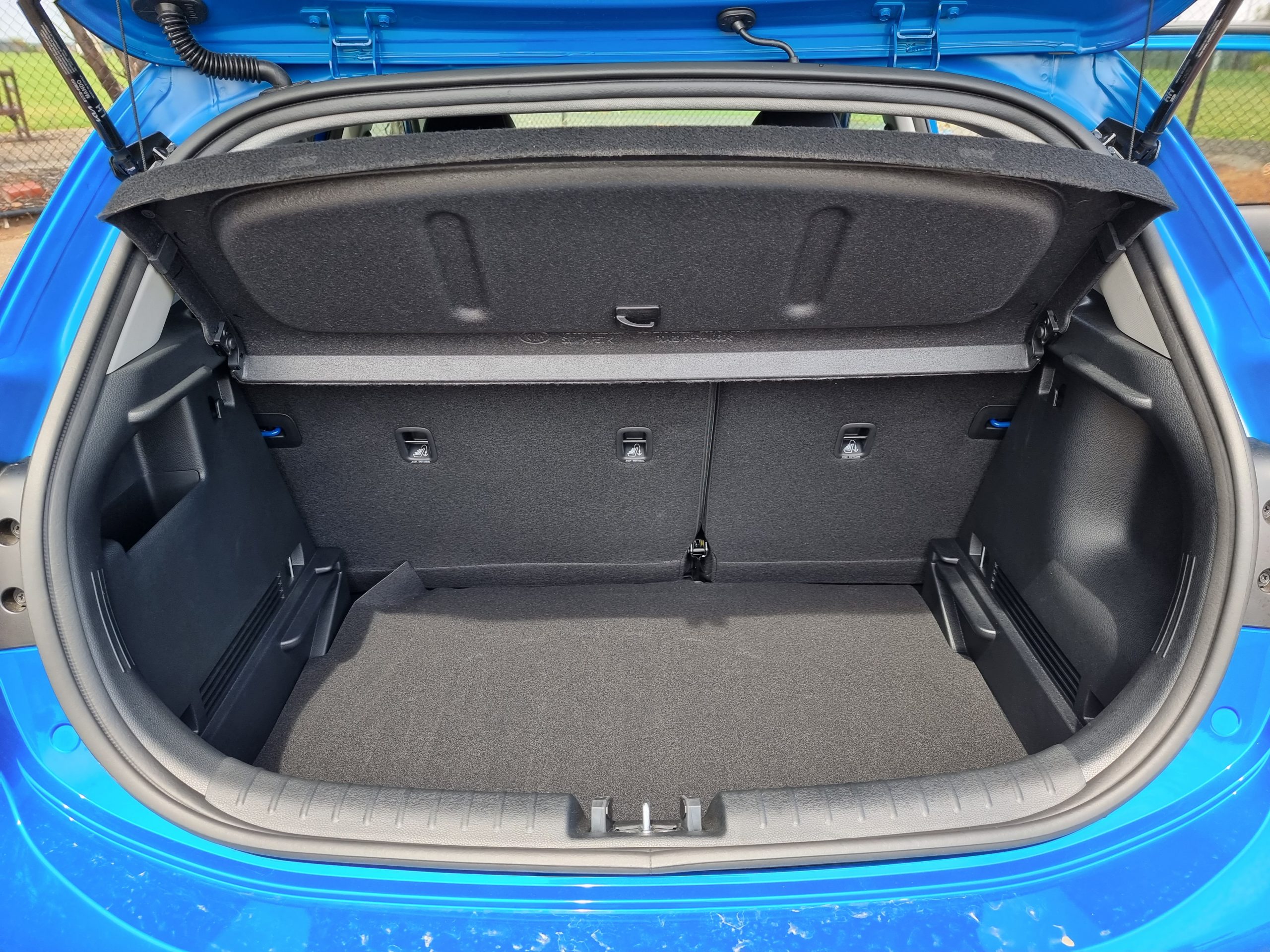
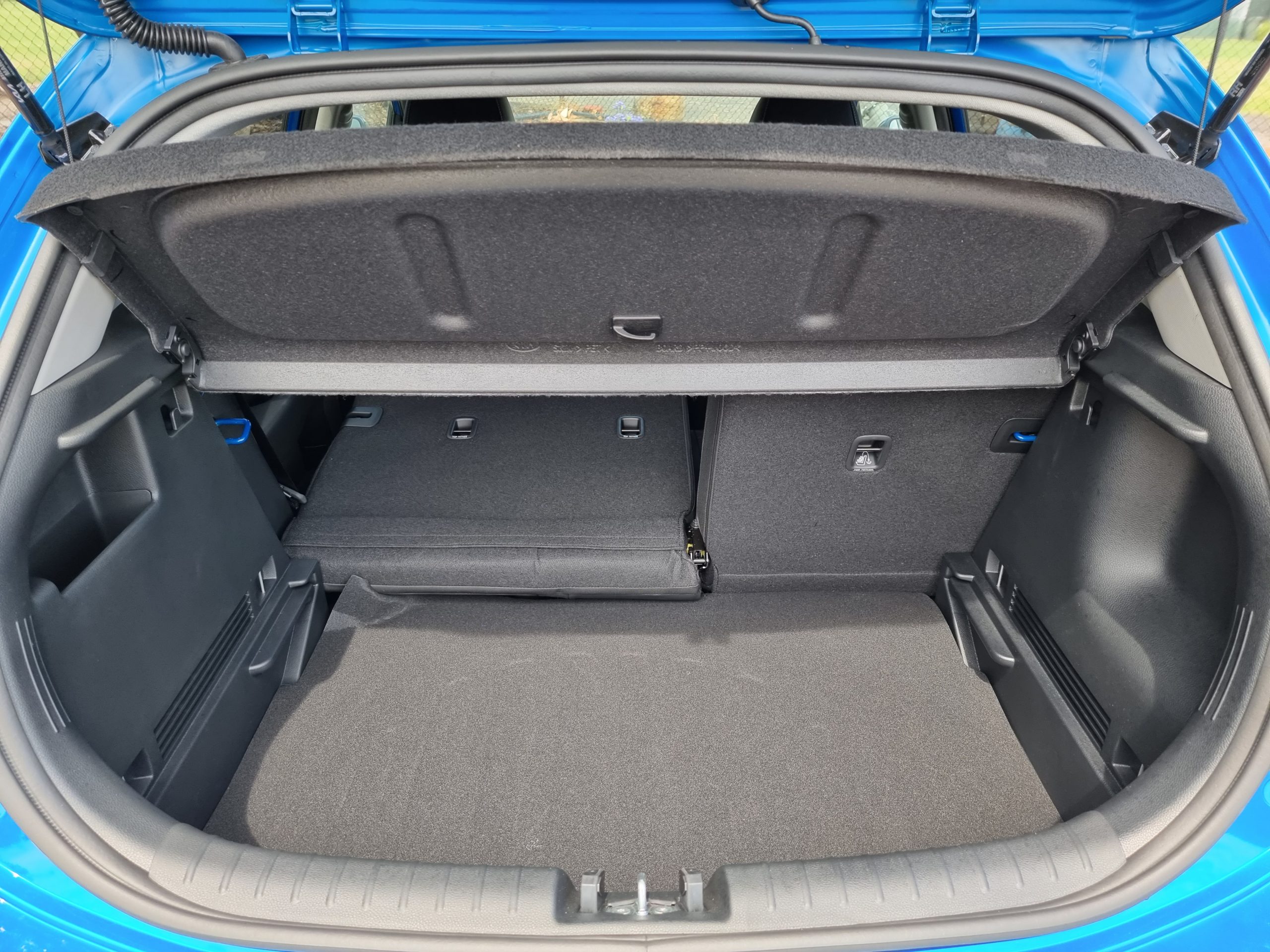
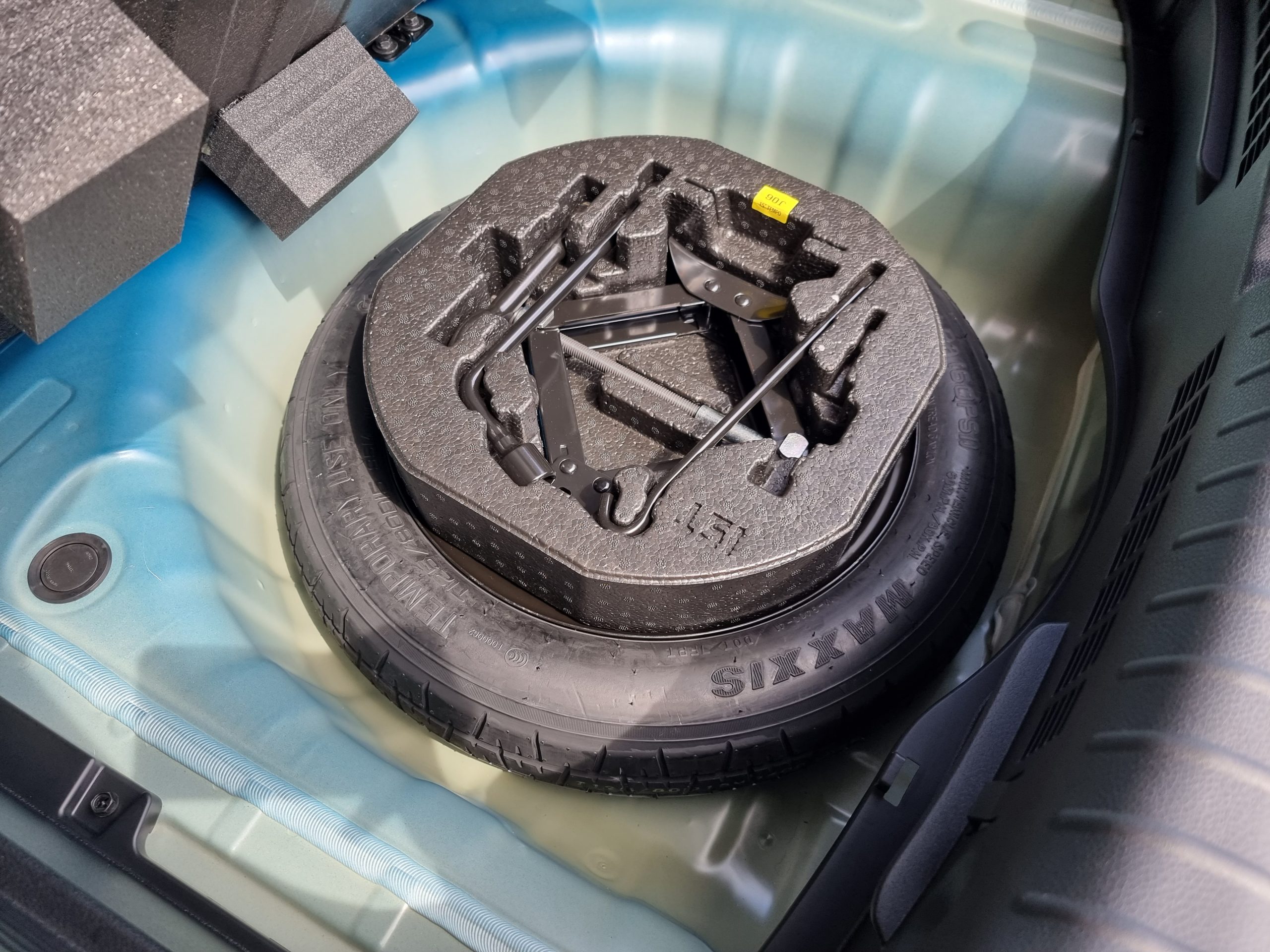
The Kia Rio’s boot is a good size too with 325 litres of space and a space saver tyre under the boot floor. The Rio doesn’t have any clever storage solutions in the boot like a Skoda might, but the 60:40 rear seatbacks still fold when needing to carry longer items. Doing so unlocks 980-litres of space.
Service & Warranty: 7/10
Like all other new Kia products, the 2022 Kia Rio GT-Line comes with a seven-year/unlimited km warranty – superior to competitors’ five-year/unlimited km equivalents. When servicing their Rio at a Kia dealership, buyers get up to eight years of roadside assistance – more than two years more than rivals (and the Toyota has none). As good as the warranty may be, the servicing costs are expensive.
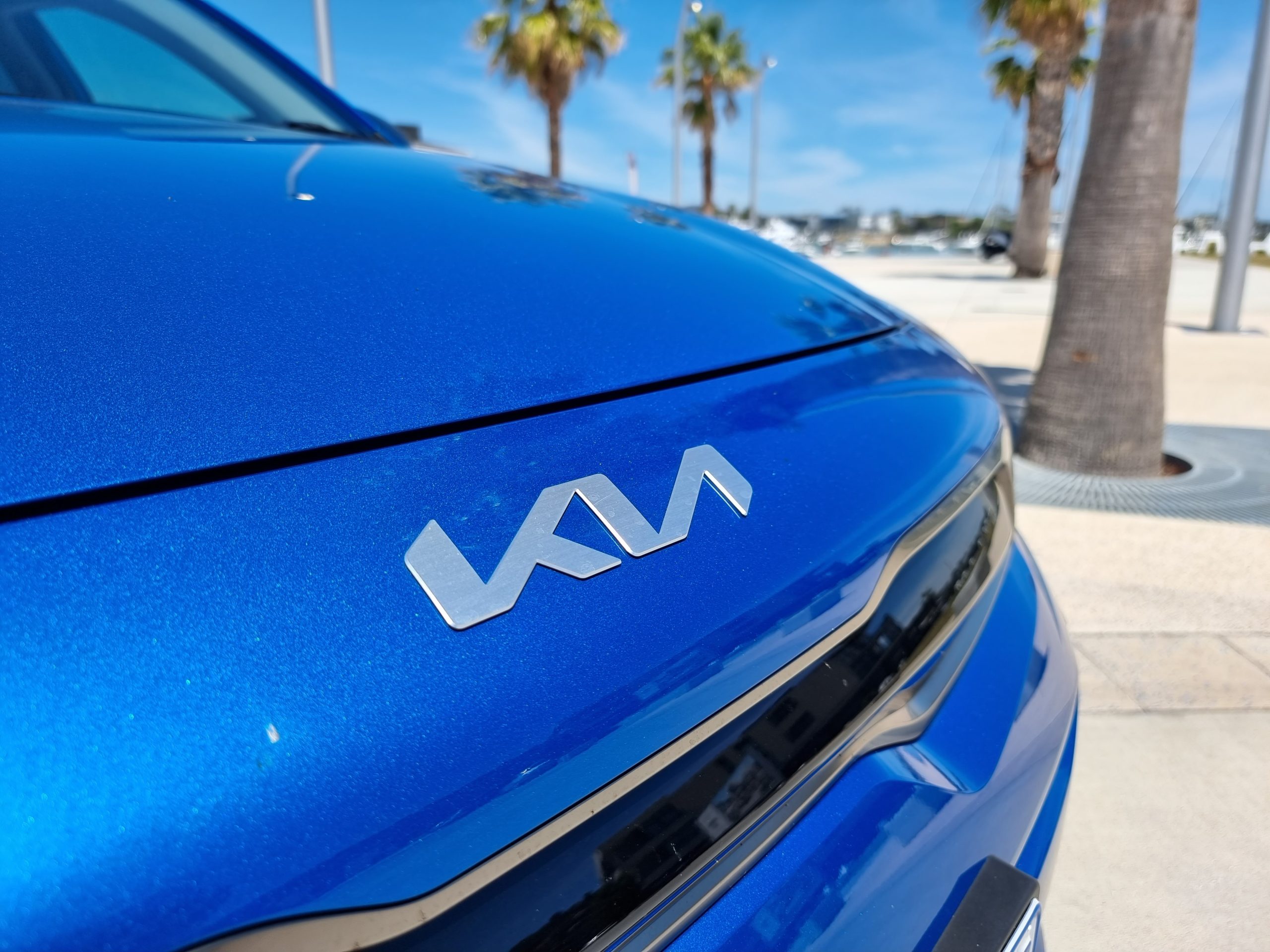
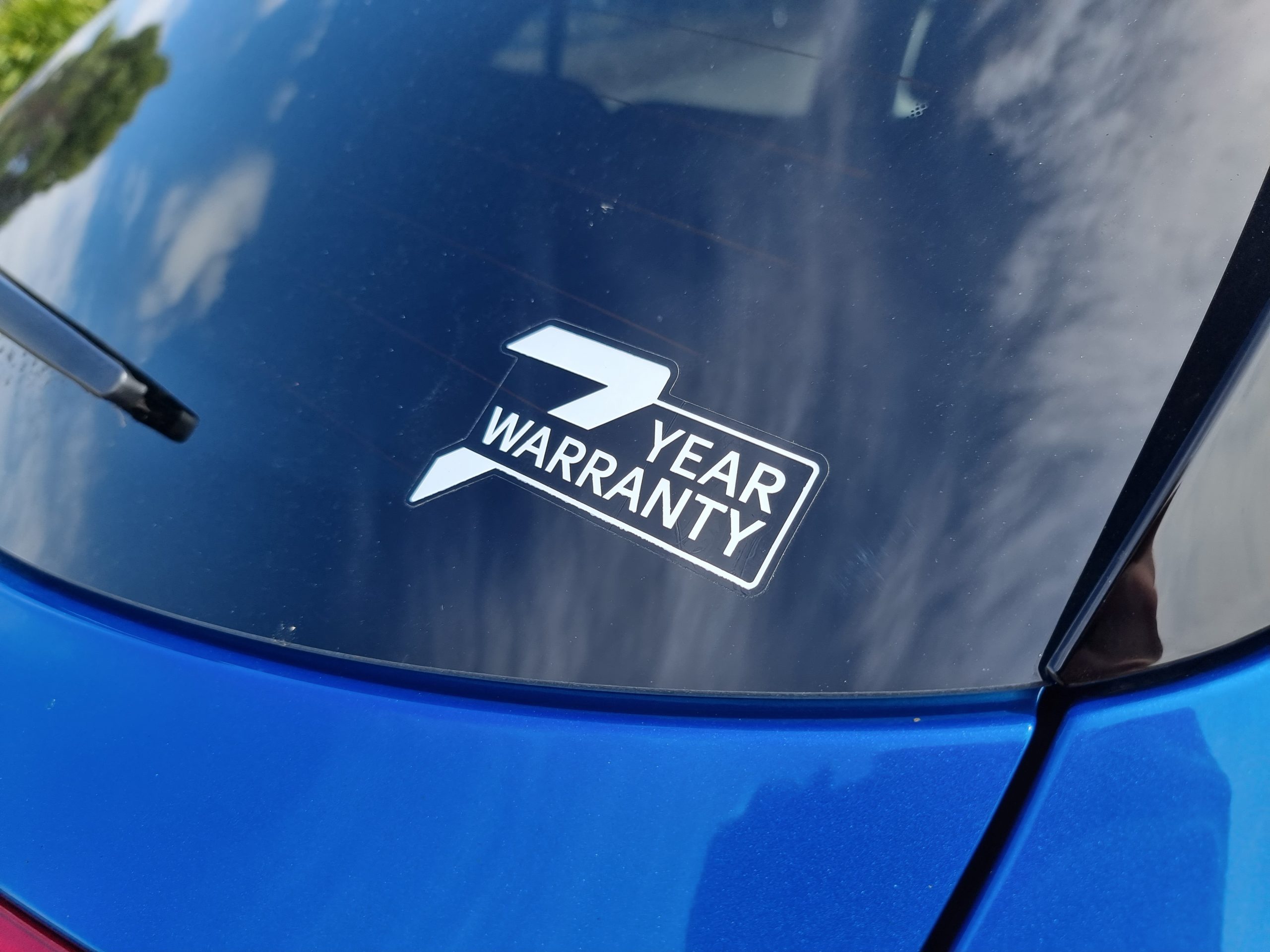
The Rio GT-Line needs to visit the dealer every 10,000kms, where lesser Rio models need only 15,000km between visits. Each service is also significantly more expensive than in other Rio models with services costing between $283 and $704 over the first five years. Five years of of Rio GT-Line ownership will set owners back $2,128 and that figure will be even higher when doing more than 10,000kms per year. A Yaris will only cost $975 over five years to service.
The 2022 Kia Rio GT-Line DiscoverAuto Rating: 6.9/10
The top of the range 2022 Kia Rio GT-Line has a lot going for it with a sporty look, roomy cabin and talented driving experience. With its turbocharged engine it feels modern and up to date in a way that lesser Rios will never feel. Sadly there are a few downsides. The spec sheet isn’t as generous as it should be, and interior quality isn’t great compared to class leaders. For a flagship model, the Rio GT-Line also feels a tad spartan and a lot of equipment offered overseas doesn’t feature in Australia. Lastly, the servicing costs make the Rio rather expensive to run and put a black mark on the usual stellar ownership experience Kia buyers can expect.
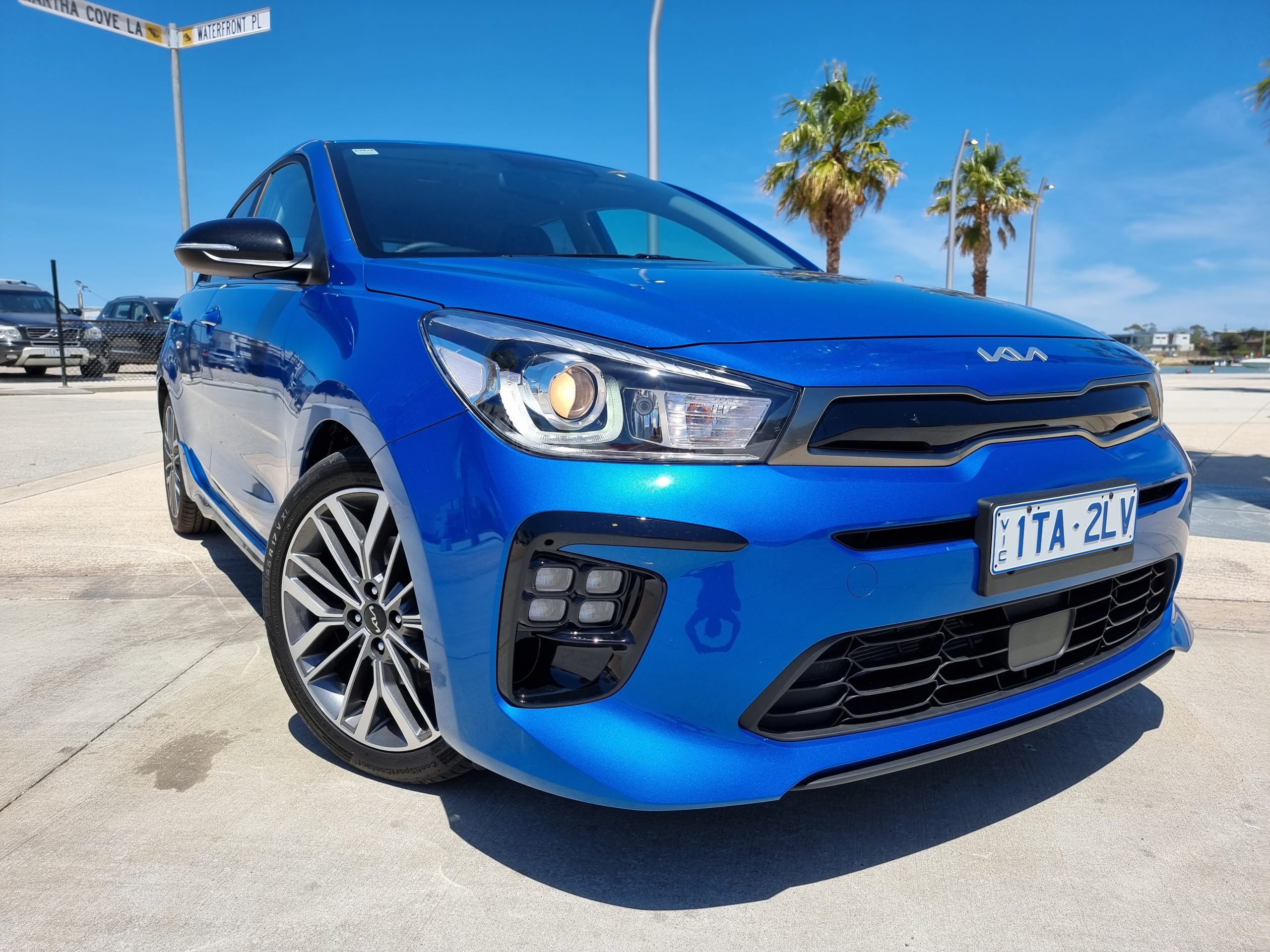
The Rio GT-Line still remains a car we would wholeheartedly recommend for first-car buyers and we would certainly have one over some small SUVs, but we feel it is a dish best served simple – in base spec without the bells and whistles of the GT-Line and its expensive servicing.
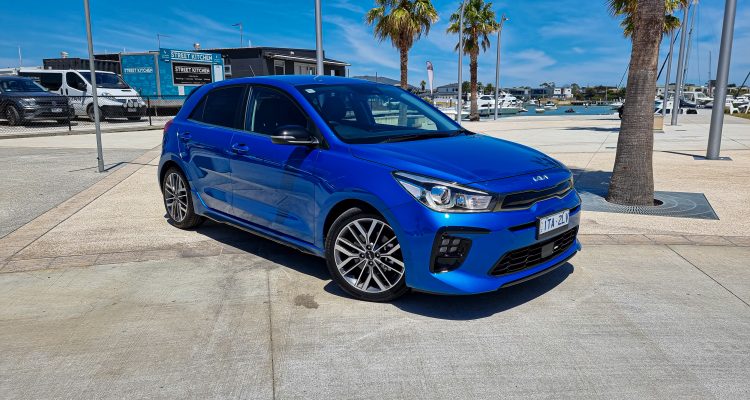
Leave a Reply